1.1 Introduction
The Milky Way, the galaxy in which we live, is
but one of many galaxies. As a matter of fact, the Milky Way, also
called the Galaxy, is a fairly average representative of the class
of spiral galaxies. Two other examples of spiral galaxies are shown
in Figs. 1.1
and 1.2,
one of which we are viewing from above (face-on), the other from
the side (edge-on). These are all stellar systems in which the
majority of stars are confined to a relatively thin disk. In our
own Galaxy, this disk can be seen as the band of stars stretched
across the night sky, which led to it being named the Milky Way.
Besides such disk galaxies, there is a second major class of
luminous stellar systems, the elliptical galaxies. Their properties
differ in many respects from those of the spirals.
It was less than a 100 years ago that astronomers
first realized that objects exist outside our Milky Way and that
our world is significantly larger than the size of the Milky Way.
In fact, galaxies are mere islands in the Universe: the diameter of
our Galaxy1 (and
other galaxies) is much smaller than the average separation between
luminous galaxies. The discovery of the existence of other stellar
systems and their variety of morphologies raised the question of
the origin and evolution of these galaxies. Is there anything
between the galaxies, or is it just empty space? Are there any
other cosmic bodies besides galaxies? Questions like these
motivated us to explore the Universe as a whole and its evolution.
Is our Universe finite or infinite? Does it change over time? Does
it have a beginning and an end? Mankind has long been fascinated by
these questions about the origin and the history of our world. But
for only a few decades have we been able to approach these
questions in an empirical manner. As we shall discuss in this book,
many of the questions have now been answered. However, each answer
raises yet more questions, as we aim towards an ever increasing
understanding of the physics of the Universe.
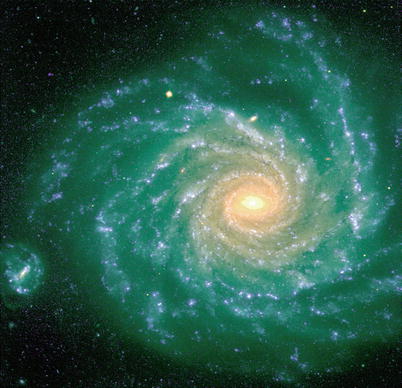
Fig. 1.1
The spiral galaxy NGC 1232 may resemble our
Milky Way if it would be observed from ‘above’ (face-on). This
image, observed with the VLT, has a size of 6.′8 ×
6.′8, corresponding to a linear size of 60 kpc at its
distance of 30 Mpc. If this was our Galaxy, our Sun would be
located at a distance of 8.0 kpc from the center, orbiting around
it at a speed of ∼ 220 km∕s. A full revolution would take us about
230 × 106 yr. The bright knots seen along the spiral
arms of this galaxy are clusters of newly-formed stars, similar to
bright young star clusters in our Milky Way. The different, more
reddish, color of the inner part of this galaxy indicates that the
average age of the stars there is higher than in the outer parts.
The small galaxy at the lower left edge of the image is a companion
galaxy that is distorted by the gravitational tidal forces caused
by the spiral galaxy. Credit: European Southern Observatory
The stars in our Galaxy have very different ages.
The oldest stars are about 12 billion years old, whereas in some
regions stars are still being born today: for instance in the
well-known Orion nebula. Obviously, the stellar content of our
Galaxy has changed over time. To understand the formation and
evolution of the Galaxy, a view of its (and thus our own) past
would be useful. Unfortunately, this is physically impossible.
However, due to the finite speed of light, we see objects at large
distances in an earlier state, as they were in the past. One can
now try to identify and analyze such distant galaxies, which may
have been the progenitors of galaxies like our own Galaxy, in this
way reconstructing the main aspects of the history of the Milky
Way. We will never know the exact initial conditions that led to
the evolution of the Milky Way, but we may be able to find some
characteristic conditions. Emerging from such initial states,
cosmic evolution should produce galaxies similar to our own, which
we would then be able to observe from the outside. On the other
hand, only within our own Galaxy can we study the physics of galaxy
evolution in situ.

Fig. 1.2
We see the spiral galaxy NGC 4565 from the
side (edge-on); an observer looking at the Milky Way from a
direction which lies in the plane of the stellar disk (‘from the
side’) may have a view like this. The disk is clearly visible, with
its central region partly obscured by a layer of dust. One also
sees the central bulge of this galaxy. As will be discussed at
length later on, spiral galaxies like this one are surrounded by a
halo of matter which is observed only through its gravitational
action, e.g., by affecting the velocity of stars and gas rotating
around the center of the galaxy. Credit: European Southern
Observatory
We are currently witnessing an epoch of
tremendous discoveries in astronomy. The technical capabilities in
observation and data reduction are currently evolving at an
enormous pace. Two examples taken from ground-based optical
astronomy should serve to illustrate this.
In 1993 the first 10-m class telescope, the Keck
telescope, was commissioned, the first increase in light-collecting
power of optical telescopes since the completion of the 5-m mirror
on Mt. Palomar in 1948. Currently, 13 telescopes with diameter
above 8 m are in use, and planning for telescopes with 30 m
diameter or more has begun. In recent years, our capabilities to
find very distant, and thus very dim, objects and to examine them
in detail have improved immensely thanks to the capability of these
large optical telescopes.
A second example is the technical evolution and
size of optical detectors. Since the introduction of CCDs
(charge-coupled devices) in astronomical observations at the end of
the 1970s, which replaced photographic plates as optical detectors,
the sensitivity, accuracy, and data rate of optical observations
have increased enormously. At the end of the 1980s, a camera with
1000 × 1000 pixels (picture
elements) was considered a wide-field
instrument. In 2003 a camera called Megacam began operating; it has
(18 000)2 pixels and images a square degree of the sky
at a sampling rate of 0.″2 in a single exposure. Such
a camera produces roughly 100 GB of data every night, the reduction
of which requires fast computers and vast storage capacities. The
largest astronomical CCD camera currently is that of the
PanSTARRS-1 telescope, with more than 1.4 billion pixels, covering
about 6 deg2 on the sky. But it is not only optical
astronomy that is in a phase of major development; there has also
been huge progress in instrumentation in other wavebands, allowing
us a multi-wavelength view of the Universe (Fig. 1.3). Space-based
observing platforms are playing a crucial role in this. We will
consider this topic in Sect. 1.3.
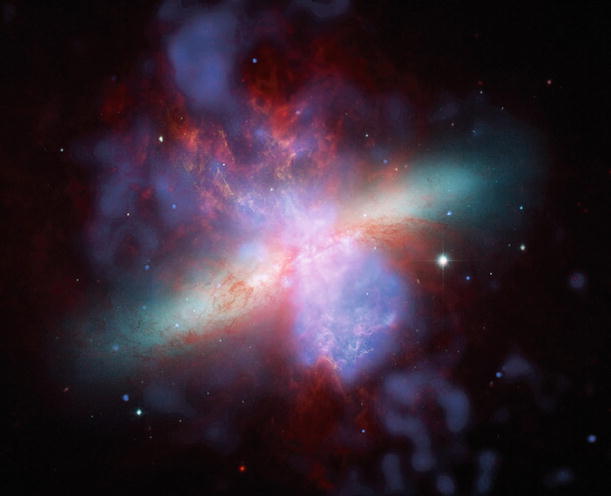
Fig. 1.3
This image of the galaxy M82 illustrates
very clearly that any given waveband provides a rather
restricted—and biased—view of cosmic objects. Shown is a composite
image, obtained from three different telescopes. Blue color shows the X-ray radiation of
this galaxy, as recorded by the X-ray satellite Chandra. The
infrared light is shown in red, and was observed with the Spitzer
Space Telescope. The optical light from M82 was recorded with the
Hubble Space Telescope and is shown in yellow-green. Finally, line emission
from hydrogen gas is displayed in orange. The distributions of radiation
from different wavelengths is obviously very different; only the
joint set of observations can provide us with an understanding of
this galaxy. In fact, M82 is a rather special object, a so-called
starburst galaxy, named because this galaxy forms new stars at a
rate much higher than this happens in the Milky Way and other
‘normal’ spiral galaxies. The stars of the galaxy are distributed
in a disk, as seen from the optical light, and most of the newly
formed stars are located close to the center. The most massive of
the stars explode in a supernova; these gigantic explosions can
heat, and drive substantial amounts of gas and dust out of the
galactic plane. The hot gas radiates X-rays and is clearly seen on
both sides of the stellar disk, as well as the dust which emits in
the infrared light. The image size is 7.′9,
corresponding 8. 5 kpc for distance of 3. 7 Mpc. Credit: X-ray:
NASA/CXC/JHU/D.Strickland; IR: NASA/JPL-Caltech/C. Engelbracht
(University of Arizona); optical: NASA, ESA, and The Hubble
Heritage Team
These technical advances have led to a vast
increase in knowledge and insight in astronomy, especially in
extragalactic astronomy and cosmology. Large telescopes and
sensitive instruments have opened up a window to the distant
Universe. Since any observation of distant objects is inevitably
also a view into the past, due to the finite speed of light,
studying objects in the early Universe has become possible. Today,
we can study galaxies which emitted the light we observe at a time
when the Universe was less than 10 % of its current age; these
galaxies are therefore in a very early evolutionary stage. We are
thus able to observe the evolution of galaxies throughout the past
history of the Universe. We have the opportunity to study the
history of galaxies and thus that of our own Milky Way. We can
examine at which epoch most of the stars that we observe today in
the local Universe have formed because the history of star
formation can be traced back to early epochs. In fact, it was found
that star formation is largely hidden from our eyes and only
observable with space-based telescopes operating in the
far-infrared waveband.
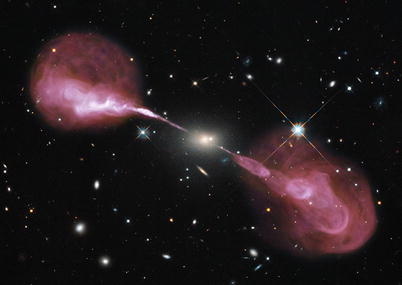
Fig. 1.4
The radio galaxy Hercules A, an elliptical
galaxy seen at the center of this image. Superposed on this optical
image is an image taken at radio wavelength, which shows a very
extended source indeed. Two streams of ionized matter, so-called
jets, are ejected on opposite sides of the galaxy, which terminate
in two extended regions, the radio lobes. The energy of the jets is
produced by a supermassive black hole with a mass of  .
Credit: NASA, ESA, S. Baum and C. O’Dea (RIT), R. Perley and W.
Cotton (NRAO/AUI/NSF), and the Hubble Heritage Team
(STScI/AURA)
.
Credit: NASA, ESA, S. Baum and C. O’Dea (RIT), R. Perley and W.
Cotton (NRAO/AUI/NSF), and the Hubble Heritage Team
(STScI/AURA)
 .
Credit: NASA, ESA, S. Baum and C. O’Dea (RIT), R. Perley and W.
Cotton (NRAO/AUI/NSF), and the Hubble Heritage Team
(STScI/AURA)
.
Credit: NASA, ESA, S. Baum and C. O’Dea (RIT), R. Perley and W.
Cotton (NRAO/AUI/NSF), and the Hubble Heritage Team
(STScI/AURA)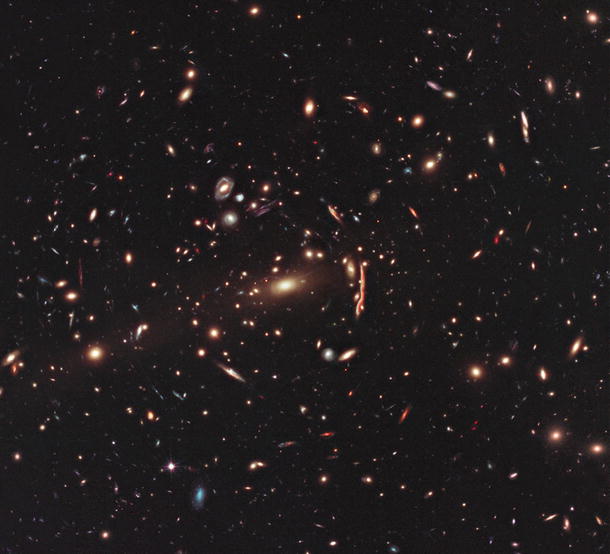
Fig. 1.5
The cluster of galaxies MACS J1206.2−0847,
as seen in a multi-color image taken by the Hubble Space Telescope.
The elliptical galaxy at the center of the image is the central
galaxy of this massive galaxy cluster; many of the member galaxies
of this clusters can be seen. They come in different shapes and
colors, some being more reddish, which indicates stellar
populations of large age, some being much bluer due to their
ongoing star formation. In addition, this image shows some objects
with rather peculiar shape. These are images of galaxies located
behind the cluster whose observed shape is deformed by
gravitational light deflection caused by the deep gravitational
potential of the cluster. This image distortion can be used to
determine the mass of this cluster, clearly showing that it
contains far more mass than is seen in the visible cluster
components. Credit: NASA, ESA, M. Postman (STScI), the CLASH Team,
and the Hubble Heritage Team (STScI/AURA)
One of the most fascinating discoveries of recent
years is that most galaxies harbor a black hole in their center,
with a characteristic mass of millions or even billions of Solar
masses—so-called supermassive black holes (see Fig. 1.4). Although as soon as
the first quasars were found in 1963 it was proposed that only
processes around a supermassive black hole would be able to produce
the huge amount of energy emitted by these ultra-luminous objects,
the idea that such black holes exist in normal galaxies is fairly
recent. Even more surprising was the finding that the black hole
mass is closely related to the other properties of its parent
galaxy, thus providing a clear indication that the evolution of
supermassive black holes is closely linked to that of their host
galaxies.
Detailed studies of individual galaxies and of
associations of galaxies, which are called galaxy groups or
clusters of galaxies (see Fig. 1.5), led to the surprising result that these
objects contain considerably more mass than is visible in the form
of stars and gas. Analyses of the dynamics of galaxies and clusters
show that only 10–20 % of their mass consists of stars, gas and
dust that we are able to observe in emission or absorption. The
largest fraction of their mass, however, is invisible. Hence, this
hidden mass is called dark
matter. We know of its presence only through its
gravitational effects. The dominance of dark matter in galaxies and
galaxy clusters was established in recent years from observations
with radio, optical and X-ray telescopes, and it was also confirmed
and quantified by other methods. However, we do not know what this
dark matter consists of; the unambiguous evidence for its existence
is called the ‘dark matter problem’.
The nature of dark matter is one of the central
questions not only in astrophysics but also poses a challenge to
fundamental physics, unless the ‘dark matter problem’ has an
astronomical solution. Does dark matter consist of non-luminous
celestial bodies, for instance burned-out stars? Or is it a new
kind of matter? Have astronomers indirectly proven the existence of
a new elementary particle which has thus far escaped detection in
terrestrial laboratories? If dark matter indeed consists of a new
kind of elementary particle, which is the common presumption today,
it should exist in the Milky Way as well, in our immediate
vicinity. Therefore, experiments which try to directly detect the
constituents of dark matter with highly sensitive and sophisticated
detectors have been set up in underground laboratories. Physicists
and astronomers are eagerly waiting for results from the Large
Hadron Collider (LHC), a particle accelerator at the European CERN
research center which started regular operation in 2009, which
produces particles at significantly higher energies than accessible
before, and which in the first few years of operation already
achieved a breakthrough with the discovery of the so-called Higgs
particle. The hope is to find hints for new physics beyond the
current Standard Model of particle physics, guiding us to extended
models of particle physics which can accommodate an elementary
particle that could serve as a constituent of dark matter.
Without doubt, the most important development in
recent years is the establishment of a standard model of cosmology,
i.e., the science of the Universe as a whole. The Universe is known
to expand and it has a finite age; we now believe that we know its
age with an uncertainty of as little as a few percent—it is
t 0 = 13. 8 Gyr.
The Universe has evolved from a very dense and very hot state, the
Big Bang, expanding and cooling over time. Even today, echoes of
the Big Bang can be observed, for example in the form of the cosmic
microwave background radiation. Accurate observations of this
background radiation, emitted some 380 000 years after the Big
Bang, i.e., at a time  , have made an
important contribution to what we know today about the composition
of the Universe. However, these results raise more questions than
they answer: only ∼ 4 % of
the energy content of the Universe can be accounted for by matter
which is well-known from other fields of physics, the baryonic matter that consists mainly of
atomic nuclei and electrons. About 25 % of the Universe consists of
dark matter, as we already discussed in the context of galaxies and
galaxy clusters. Recent observational results have shown that the
mean density of dark matter dominates over that of baryonic matter
also on cosmic scales.
, have made an
important contribution to what we know today about the composition
of the Universe. However, these results raise more questions than
they answer: only ∼ 4 % of
the energy content of the Universe can be accounted for by matter
which is well-known from other fields of physics, the baryonic matter that consists mainly of
atomic nuclei and electrons. About 25 % of the Universe consists of
dark matter, as we already discussed in the context of galaxies and
galaxy clusters. Recent observational results have shown that the
mean density of dark matter dominates over that of baryonic matter
also on cosmic scales.
 , have made an
important contribution to what we know today about the composition
of the Universe. However, these results raise more questions than
they answer: only ∼ 4 % of
the energy content of the Universe can be accounted for by matter
which is well-known from other fields of physics, the baryonic matter that consists mainly of
atomic nuclei and electrons. About 25 % of the Universe consists of
dark matter, as we already discussed in the context of galaxies and
galaxy clusters. Recent observational results have shown that the
mean density of dark matter dominates over that of baryonic matter
also on cosmic scales.
, have made an
important contribution to what we know today about the composition
of the Universe. However, these results raise more questions than
they answer: only ∼ 4 % of
the energy content of the Universe can be accounted for by matter
which is well-known from other fields of physics, the baryonic matter that consists mainly of
atomic nuclei and electrons. About 25 % of the Universe consists of
dark matter, as we already discussed in the context of galaxies and
galaxy clusters. Recent observational results have shown that the
mean density of dark matter dominates over that of baryonic matter
also on cosmic scales.Even more surprising than the existence of dark
matter is the discovery that about 70 % of the Universe consists of
something that today is called vacuum energy, or dark energy, and
that is closely related to the cosmological constant introduced by
Albert Einstein. The fact that various names do exist for it by no
means implies that we have any idea what this dark energy is. It
reveals its existence exclusively in its effect on the cosmic
expansion, and it even dominates the expansion dynamics at the
current epoch. Any efforts to estimate the density of dark energy
from fundamental physics have failed hopelessly up to now. An
estimate of the vacuum energy density using quantum mechanics
results in a value that is roughly 120 orders of magnitude larger than the
value derived from cosmology. For the foreseeable future
observational cosmology will be the only empirical probe for dark
energy, and an understanding of its physical nature probably has to
wait for quite a number of years. The existence of dark energy may
well pose the greatest challenge to fundamental physics
today.
In this book we will present a discussion of the
extragalactic objects found in astronomy, but we will start with
describing the Milky Way which, being a typical spiral galaxy, is
considered a prototype of this class of stellar systems. The other
central topic in this book is a presentation of modern
astrophysical cosmology, which has experienced tremendous advances
in recent years. Methods and results will be discussed in parallel.
Besides providing an impression of the fascination that arises from
astronomical observations and cosmological insights, astronomical
methods and physical considerations will be our prime focus. We
will start in the next section with a concise overview of the
fields of extragalactic astronomy and cosmology. This is, on the
one hand, intended to whet the reader’s appetite and curiosity, and
on the other hand to introduce some facts and technical terms that
will be needed in what follows but which are discussed in detail
only later in the book. In Sect. 1.3 we will describe some of the most important
telescopes used in extragalactic astronomy today, and some of the
most useful astronomical surveys having a broad range of
applications are mentioned in Sect. 1.4.
1.2 Overview
1.2.1 Our Milky Way as a galaxy
The Milky Way is the only galaxy which we are
able to examine in great detail. We can resolve individual stars
and analyze them spectroscopically. We can perform detailed studies
of the interstellar medium (ISM), such as the properties of
molecular clouds and star forming regions. We can quantitatively
examine extinction and reddening by dust. Furthermore, we can
observe the local dynamics of stars and gas clouds as well as the
properties of satellite galaxies (such the Magellanic Clouds).
Finally, the Galactic center at a distance of only 8 kpc gives us
the unique opportunity to examine the central region of a galaxy at
very high resolution.2 Only through a detailed understanding
of our own Galaxy can we hope to understand the properties of other
galaxies. Of course, we implicitly assume that the physical
processes taking place in other galaxies obey the same laws of
physics that apply to us. If this were not the case, we would
barely have a chance to understand the physics of other objects in
the Universe, let alone the Universe as a whole. We will return to
this point shortly.
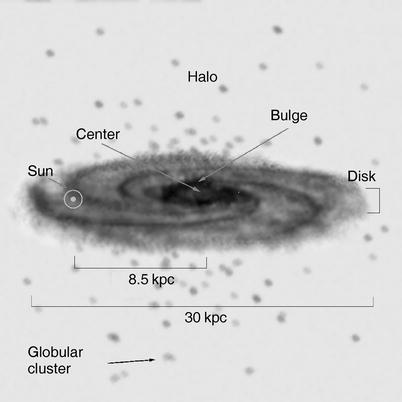
Fig. 1.6
Schematic structure of the Milky Way
consisting of the disk, the central bulge with the Galactic center,
and the spherical halo in which most of the globular clusters are
located. The Sun orbits around the Galactic center at a distance of
about 8 kpc
We will first discuss the properties of our own
Galaxy. One of the main problems here, and in astronomy in general,
is the determination of the distance to an object. Thus we will
start by considering this topic. From the analysis of the
distribution of stars and gas in the Milky Way we will then derive
its structure. It is found that the Galaxy consists of several
distinct components:
-
a thin disk of stars and gas with a radius of about 20 kpc and a scale height of about 300 pc, which also hosts the Sun;
-
a ∼ 1 kpc thick disk, which contains a different, older stellar population compared to the thin disk;
-
a central bulge, as is also found in other spiral galaxies;
-
and a nearly spherical halo which contains most of the globular clusters, some old stars, and gas with different densities and temperatures.
Figure 1.6 shows a schematic view of our Milky Way and
its various components. For a better visual impression,
Figs. 1.1
and 1.2
show two spiral galaxies, the former viewed from ‘above’ (face-on)
and the latter from the ‘side’ (edge-on). In the former case, the
spiral structure, from which this kind of galaxy derives its name,
is clearly visible. The bright knots in the spiral arms are regions
where young, luminous stars have recently formed. The image shows
an obvious color gradient: the galaxy is redder in the center and
bluest in the spiral arms—while star formation is currently taking
place in the spiral arms, we find mainly old stars towards the
center, especially in the bulge.
The Galactic disk rotates, with rotational
velocity V (R) depending on the distance
R from the center. We can
estimate the mass of the Galaxy from the distribution of the
stellar light and the mean mass-to-light ratio of the stellar
population, since gas and dust represent less
than ∼ 10 % of the mass of
the stars. From this mass estimate we can predict the rotational
velocity as a function of radius simply from Newtonian mechanics.
However, the observed rotational velocity of the Sun around the
Galactic center is significantly higher than would be expected from
the observed mass distribution. If M(R 0) is the mass inside a
sphere around the Galactic center with radius R 0 ≈ 8 kpc, then the
rotational velocity from Newtonian mechanics3 is
 From the visible matter in stars we would expect a rotational
velocity of ∼ 160 km∕s, but we observe V 0 ∼ 220 km∕s (see
Fig. 1.7).
This discrepancy, and the shape of the rotation curve V (R) for larger distances R from the Galactic center, indicates
that our Galaxy contains significantly more mass than is visible in
the form of stars.4
This additional mass is called dark matter. Its physical nature is
still unknown. The main candidates are weakly interacting
elementary particles like those postulated by some elementary
particle theories, but they have yet not been detected in the
laboratory. Macroscopic objects (i.e., celestial bodies) are also
in principle viable candidates if they emit very little light. We
will discuss experiments which allow us to identify such
macroscopic objects and come to the conclusion that the solution of
the dark matter problem probably can not be found in astronomy, but
rather most likely in particle physics.
From the visible matter in stars we would expect a rotational
velocity of ∼ 160 km∕s, but we observe V 0 ∼ 220 km∕s (see
Fig. 1.7).
This discrepancy, and the shape of the rotation curve V (R) for larger distances R from the Galactic center, indicates
that our Galaxy contains significantly more mass than is visible in
the form of stars.4
This additional mass is called dark matter. Its physical nature is
still unknown. The main candidates are weakly interacting
elementary particles like those postulated by some elementary
particle theories, but they have yet not been detected in the
laboratory. Macroscopic objects (i.e., celestial bodies) are also
in principle viable candidates if they emit very little light. We
will discuss experiments which allow us to identify such
macroscopic objects and come to the conclusion that the solution of
the dark matter problem probably can not be found in astronomy, but
rather most likely in particle physics.

(1.1)
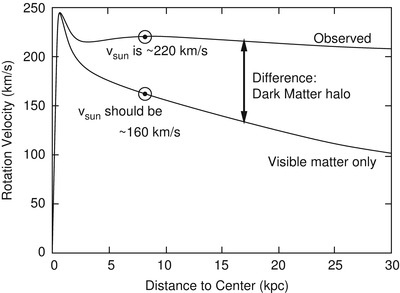
Fig. 1.7
The upper
curve is the observed rotation curve V (R) of our Galaxy, i.e., the rotational
velocity of stars and gas around the Galactic center as a function
of their galacto-centric distance. The lower curve is the rotation curve that
we would predict based solely on the observed stellar mass of the
Galaxy. The difference between these two curves is ascribed to the
presence of dark matter, in which the Milky Way disk is embedded.
This image is adapted from Nick Strobel’s webpage at www.astronomynotes.com
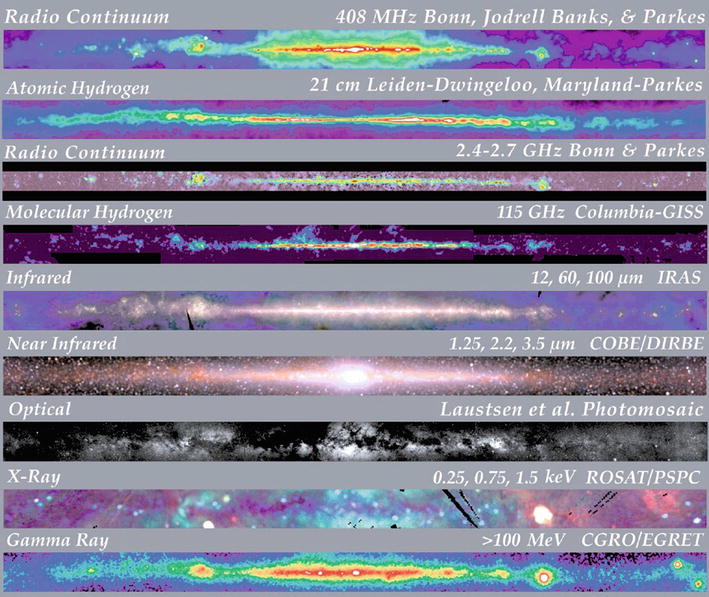
Fig. 1.8
The Galactic disk observed in nine
different wavebands. Its appearance differs strongly in the various
images; for example, the distribution of atomic hydrogen and of
molecular gas is much more concentrated towards the Galactic plane
than the distribution of stars observed in the near-infrared, the
latter clearly showing the presence of a central bulge. The
absorption by dust at optical wavelengths is also clearly visible
and can be compared to that in Fig. 1.2. Credit: NASA’s
Goddard Space Flight Center
The stars in the various components of our Galaxy
have different properties regarding their age and their chemical
composition. By interpreting this fact one can infer some aspects
of the evolution of the Galaxy. The relatively young age of the
stars in the thin disk, compared to that of the older population in
the bulge, suggests different phases in the formation and evolution
of the Milky Way. Indeed, our Galaxy is a highly dynamic object
that is still changing today. We see cold gas falling into the
Galactic disk and hot gas outflowing. Currently the small
neighboring Sagittarius dwarf galaxy is being torn apart in the
tidal gravitational field of the Milky Way and will merge with it
in the (cosmologically speaking) near future.
One cannot see far through the disk of the Galaxy
at optical wavelengths due to extinction by dust. Therefore, the
immediate vicinity of the Galactic center can be examined only in
other wavebands, especially the infrared (IR) and the radio parts
of the electromagnetic spectrum (see also Fig. 1.8). The Galactic center
is a highly complex region but we have been able to study it in
recent years thanks to various substantial improvements in IR
observations regarding sensitivity and angular resolution. Proper
motions, i.e., changes of the positions on the sky with time, of
bright stars close to the center have been observed. They enable us
to determine the mass M
inside a volume of radius ∼ 0. 1 pc to be  .
Although the data do not allow us to make a totally unambiguous
interpretation of this mass concentration there is no plausible
alternative to the conclusion that the center of the Milky Way
harbors a supermassive black hole (SMBH) of roughly this mass. And
yet this SMBH is far less massive than the ones that have been
found in many other galaxies.
.
Although the data do not allow us to make a totally unambiguous
interpretation of this mass concentration there is no plausible
alternative to the conclusion that the center of the Milky Way
harbors a supermassive black hole (SMBH) of roughly this mass. And
yet this SMBH is far less massive than the ones that have been
found in many other galaxies.
 .
Although the data do not allow us to make a totally unambiguous
interpretation of this mass concentration there is no plausible
alternative to the conclusion that the center of the Milky Way
harbors a supermassive black hole (SMBH) of roughly this mass. And
yet this SMBH is far less massive than the ones that have been
found in many other galaxies.
.
Although the data do not allow us to make a totally unambiguous
interpretation of this mass concentration there is no plausible
alternative to the conclusion that the center of the Milky Way
harbors a supermassive black hole (SMBH) of roughly this mass. And
yet this SMBH is far less massive than the ones that have been
found in many other galaxies.Unfortunately, we are unable to look at our
Galaxy from the outside. This view from the inside renders it
difficult to observe the global properties of the Milky Way. The
structure and geometry of the Galaxy, e.g., its spiral arms, are
hard to identify from our location. In addition, the extinction by
dust hides large parts of the Galaxy from our view (see
Fig. 1.9), so
that the global parameters of the Milky Way (like its total
luminosity) are difficult to measure. These parameters are
estimated much better from outside, i.e., in other similar spiral
galaxies. In order to understand the large-scale properties of our
Galaxy, a comparison with similar galaxies which we can examine in
their entirety is extremely helpful. Only by combining the study of
the Milky Way with that of other galaxies can we hope to fully
understand the physical nature of galaxies and their
evolution.
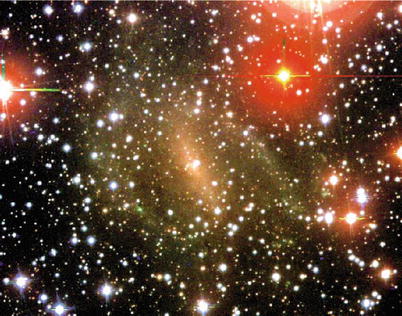
Fig. 1.9
The galaxy Dwingeloo 1 is only five times
more distant than our closest large neighboring galaxy, Andromeda,
yet it was not discovered until the 1990s because it hides behind
the Galactic center. The absorption in this direction and numerous
bright stars prevented it from being discovered earlier. The figure
shows an image observed with the Isaac Newton Telescope in the V,
R, and I bands. Credit: S. Hughes & S. Maddox; Isaac Newton
Telescope
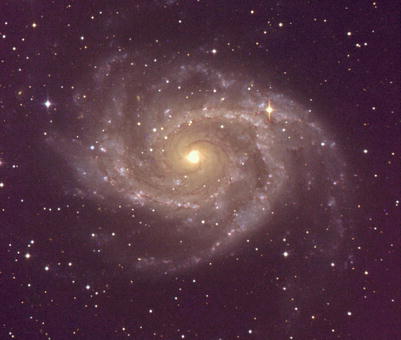
Fig. 1.10
NGC 2997 is a typical spiral galaxy, with
its disk inclined by about 45∘ with respect to the
line-of-sight. Like most spiral galaxies it has two spiral arms;
they are significantly bluer than other parts of the galaxy. This
is caused by ongoing star formation in these regions so that young,
hot and thus blue stars are present in the arms, whereas the center
of the galaxy, especially the bulge, consists mainly of old stars.
Credit: M. Altmann, Sternwarte der Universität Bonn
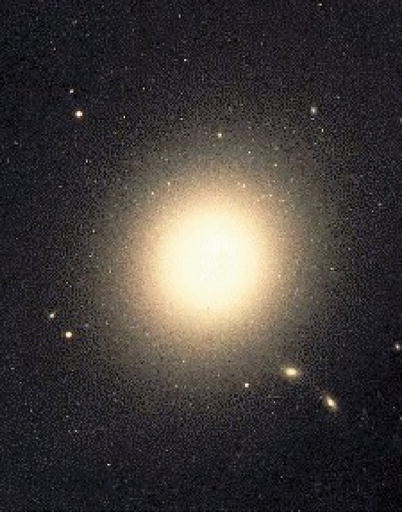
Fig. 1.11
M87 is a very luminous elliptical galaxy in
the center of the Virgo cluster, at a distance of about 18 Mpc. The
diameter of the visible part of this galaxy is about 40 kpc; it is
significantly more massive than the Milky Way ( ). We will
frequently refer to this galaxy: it is not only an excellent
example of a central cluster galaxy but also a representative of
the family of ‘active galaxies’. It is a strong radio emitter
(radio astronomers also know it as Virgo A), and it has an optical
jet in its center. Credit: S. Frey & J.E. Gunn,
Princeton University
). We will
frequently refer to this galaxy: it is not only an excellent
example of a central cluster galaxy but also a representative of
the family of ‘active galaxies’. It is a strong radio emitter
(radio astronomers also know it as Virgo A), and it has an optical
jet in its center. Credit: S. Frey & J.E. Gunn,
Princeton University
 ). We will
frequently refer to this galaxy: it is not only an excellent
example of a central cluster galaxy but also a representative of
the family of ‘active galaxies’. It is a strong radio emitter
(radio astronomers also know it as Virgo A), and it has an optical
jet in its center. Credit: S. Frey & J.E. Gunn,
Princeton University
). We will
frequently refer to this galaxy: it is not only an excellent
example of a central cluster galaxy but also a representative of
the family of ‘active galaxies’. It is a strong radio emitter
(radio astronomers also know it as Virgo A), and it has an optical
jet in its center. Credit: S. Frey & J.E. Gunn,
Princeton University1.2.2 The world of galaxies
Next we will discuss the properties of other
galaxies. The two main types of galaxies are spirals (like the
Milky Way, see also Fig. 1.10) and elliptical galaxies
(Fig. 1.11).
Besides these, there are additional classes such as irregular and
dwarf galaxies, active galaxies, and starburst galaxies, where the
latter have a very high star-formation rate in comparison to normal
galaxies. These classes differ not only in their morphology, which
forms the basis for their classification, but also in their
physical properties such as color (indicating a different stellar
content), internal reddening (depending on their dust content),
amount of interstellar gas, star-formation rate, etc. Galaxies of
different morphologies have evolved in different ways.
Spiral galaxies are stellar systems in which
active star formation is still taking place today, whereas
elliptical galaxies consist mainly of old stars—their star
formation was terminated a long time ago. The S0 galaxies, an
intermediate type, show a disk similar to that of spiral galaxies
but like ellipticals they consist mainly of old stars, i.e., stars
of low mass and low temperature. Ellipticals and S0 galaxies
together are often called early-type galaxies, whereas spirals
are termed late-type
galaxies. These names do not imply any interpretation but
exist only for historical reasons.
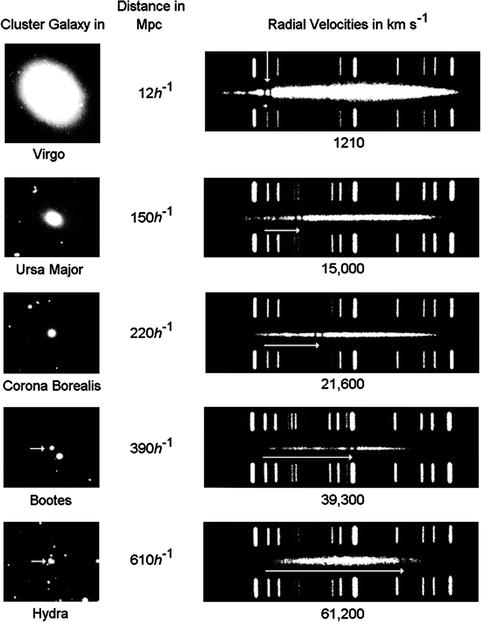
Fig. 1.12
The spectra of galaxies show characteristic
spectral lines, e.g., the H+K lines of calcium. These lines,
however, do not appear at the wavelengths measured in the
laboratory but are in general shifted towards longer wavelengths.
This is shown here for a set of sample galaxies, with distance
increasing from top to bottom. The shift in the lines, interpreted
as being due to the Doppler effect, allows us to determine the
relative radial velocity—the larger it is, the more distant the
galaxy is. The discrete lines above and below the spectra are for
calibration purposes only. Credit: Hale Observatories; J. Silk, The
Big Bang, 2nd Ed.

Fig. 1.13
The original 1929 version of the Hubble
diagram shows the radial velocity of galaxies as a function of
their distance. The reader may notice that the velocity axis is
labeled with erroneous units—of course they should read km/s. While
the radial (escape) velocity is easily measured by means of the
Doppler shift in spectral lines, an accurate determination of
distances is much more difficult; we will discuss methods of
distance determination for galaxies in Sect. 3.9. Hubble has underestimated the
distances considerably, resulting in too high a value for the
Hubble constant. Only very few and very close galaxies show a
blueshift, i.e., they move towards us; one of these is Andromeda
( = M31). Adapted from: E. Hubble 1929, A Relation between Distance and Radial
Velocity among Extra-Galactic Nebulae,
Proc. Nat. Academy Sciences 15, No. 3, March 15,
1929, Fig. 1
The disks of spiral galaxies rotate
differentially. As for the Milky Way, one can determine the mass
from the rotational velocity using the Kepler
law (1.1). One finds that, contrary to the
expectation from the distribution of light, the rotation curve does
not decline at larger distances from the center. Like our own Galaxy, spiral galaxies contain a
large amount of dark matter; the visible matter is embedded in a
halo of dark matter. We can only get rough estimates of the
extent of this halo, but there are strong indications that it is
substantially larger than the extent of the visual matter. For
instance, the rotation curve is flat up to the largest radii where
one still finds gas to measure the velocity. Studying dark matter
in elliptical galaxies is more complicated, but the existence of
dark halos has also been proven for ellipticals.
The Hertzsprung–Russell diagram of stars, or
their color-magnitude diagram (see Appendix B), has turned out
to be the most important diagram in stellar astrophysics. The fact
that most stars are aligned along a one-dimensional sequence, the
main sequence, led to the conclusion that, for main sequence stars,
the luminosity and the surface temperature are not independent
parameters. Instead, the properties of such stars are in principle
characterized by only a single parameter: the stellar mass. We will
also see that the various properties of galaxies are not
independent parameters. Rather, dynamical properties (such as the
rotational velocity of spirals) are closely related to the
luminosity. These scaling relations are of similar importance to
the study of galaxies as the Hertzsprung–Russell diagram is for
stars. In addition, they turn out to be very convenient tools for
the determination of galaxy distances.
Like our Milky Way, other galaxies also seem to
harbor a SMBH in their center. We obtained the astonishing result
that the mass of such a SMBH is closely related to the velocity
distribution of stars in elliptical galaxies or in the bulge of
spirals. The physical reason for this close correlation is as yet
not known in detail, but it strongly suggests a joint evolution of
galaxies and their SMBHs.
1.2.3 The Hubble expansion of the Universe
The radial velocity of galaxies, measured by
means of the Doppler shift of spectral lines (Fig. 1.12), is positive for
nearly all galaxies, i.e., they appear to be moving away from us.
In 1928, Edwin Hubble discovered that this escape velocity
v increases with the
distance of the galaxy. He identified a linear relation between the
radial velocity v and the
distance D of galaxies,
called the Hubble law,
 where H 0 is a
constant. If we plot the radial velocity of galaxies against their
distance, as is done in the Hubble diagram of Fig. 1.13, the resulting
points are approximated by a straight line, with the slope being
determined by the constant of proportionality, H 0, which is called the
Hubble constant. The fact
that all galaxies seem to move away from us with a velocity which
increases linearly with their distance is interpreted such that the
Universe is expanding. We will see later that this Hubble expansion of the Universe is a
natural property of cosmological world models.
where H 0 is a
constant. If we plot the radial velocity of galaxies against their
distance, as is done in the Hubble diagram of Fig. 1.13, the resulting
points are approximated by a straight line, with the slope being
determined by the constant of proportionality, H 0, which is called the
Hubble constant. The fact
that all galaxies seem to move away from us with a velocity which
increases linearly with their distance is interpreted such that the
Universe is expanding. We will see later that this Hubble expansion of the Universe is a
natural property of cosmological world models.

(1.2)
For a long time, the value of H 0 was uncertain by almost
a factor of two. However, in recent years the uncertainty was
reduced to about 5 %, yielding
 obtained from several different methods which will be discussed
later. The error margins vary for the different methods. The main
problem in determining H
0 is in measuring the absolute distance of galaxies (as
will be discussed in Sect. 3.9), whereas Doppler shifts are
easily measurable. If one assumes (1.2) to be valid, the
radial velocity of a galaxy is a measure of its distance. One
defines the redshift,
z, of an object from the
wavelength shift in spectral lines,
obtained from several different methods which will be discussed
later. The error margins vary for the different methods. The main
problem in determining H
0 is in measuring the absolute distance of galaxies (as
will be discussed in Sect. 3.9), whereas Doppler shifts are
easily measurable. If one assumes (1.2) to be valid, the
radial velocity of a galaxy is a measure of its distance. One
defines the redshift,
z, of an object from the
wavelength shift in spectral lines,
 with λ 0
denoting the wavelength of a spectral transition in the rest-frame
of the emitter and λ
obs the observed wavelength. For instance, the
Lyman-α transition, i.e.,
the transition from the first excited level to the ground state in
the hydrogen atom is at λ
0 = 1216 Å. For small redshifts,
with λ 0
denoting the wavelength of a spectral transition in the rest-frame
of the emitter and λ
obs the observed wavelength. For instance, the
Lyman-α transition, i.e.,
the transition from the first excited level to the ground state in
the hydrogen atom is at λ
0 = 1216 Å. For small redshifts,
 whereas this relation has to be modified for large redshifts,
together with the interpretation of the redshift itself. 5
Combining (1.2) and (1.5), we obtain
whereas this relation has to be modified for large redshifts,
together with the interpretation of the redshift itself. 5
Combining (1.2) and (1.5), we obtain
 where the uncertainty in determining H 0 is parametrized by the
scaled Hubble constant h,
defined as
where the uncertainty in determining H 0 is parametrized by the
scaled Hubble constant h,
defined as
 Distance determinations based on redshift therefore always contain
a factor of h
−1, as seen in (1.6). With the recent determination of the
Hubble constant (1.3), we have h = 0. 71 ± 0. 04. It needs to be
emphasized once more that (1.5) and (1.6) are valid only for
z ≪ 1; the generalization
for larger redshifts will be discussed in Sect. 4.3. Nevertheless, z is also a measure of distance for
large redshifts.
Distance determinations based on redshift therefore always contain
a factor of h
−1, as seen in (1.6). With the recent determination of the
Hubble constant (1.3), we have h = 0. 71 ± 0. 04. It needs to be
emphasized once more that (1.5) and (1.6) are valid only for
z ≪ 1; the generalization
for larger redshifts will be discussed in Sect. 4.3. Nevertheless, z is also a measure of distance for
large redshifts.

(1.3)

(1.4)

(1.5)

(1.6)

(1.7)
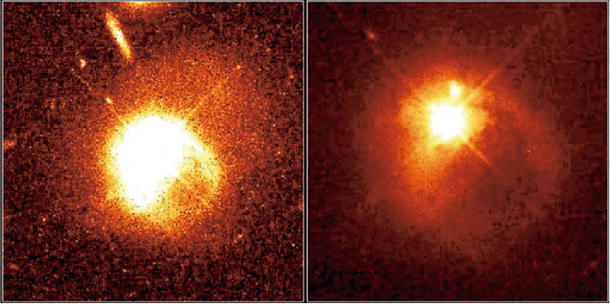
Fig. 1.14
The quasar PKS 2349 is located at the
center of a galaxy, its host galaxy. The two images shown here
differ only in their brightness contrast. The diffraction spikes
(diffraction patterns caused by the suspension of the telescope’s
secondary mirror) in the middle of the object show that the center
of the galaxy contains a point source, the actual quasar, which is
significantly brighter than its host galaxy. The galaxy shows clear
signs of distortion, visible as large and thin tidal tails. The
tails are caused by a neighboring galaxy that is visible in the
right-hand image, just
above the quasar; it is about the size of the Large Magellanic
Cloud. Quasar host galaxies are often distorted or in the process
of merging with other galaxies. Credit: J. Bahcall (IAS,
Princeton), M. Disney (University of Wales), NASA
1.2.4 Active galaxies and starburst galaxies
A special class of galaxies are the so-called
active galaxies which have a very strong energy source in their
center (active galactic nucleus, AGN). The best-known
representatives of these AGNs are the quasars, objects typically at
high redshift and with quite exotic properties. Their spectrum
shows strong emission lines which can be extremely broad, with a
relative width of Δ
λ∕λ ∼ 0. 03. The
line width is caused by very high random velocities of the gas
which emits these lines: if we interpret the line width as due to
Doppler broadening resulting from the superposition of lines of
emitting gas with a very broad velocity distribution, we obtain
velocities of typically Δ
v ∼ 10 000 km∕s. The central source in these objects is much
brighter than the other parts of the galaxy, making these sources
appear nearly point-like on optical images. Only with the Hubble
Space Telescope (HST) did astronomers succeed in detecting
structure in the optical emission for a large sample of quasars
(Fig. 1.14).
Many properties of quasars resemble those of
Seyfert type I galaxies, which are galaxies with a very luminous
nucleus and very broad emission lines. For this reason, quasars are
considered as particularly luminous members of this class. The
total luminosity of quasars is extremely large, with some of them
emitting more than a 1000 times the luminosity of our Galaxy. In
addition, this radiation must originate from a very small spatial
region whose size can be estimated, e.g., from the variability
time-scale of the source. Due to these and other properties which
will be discussed in Chap. 5, it is concluded that the nuclei of
active galaxies must contain a supermassive black hole as the
central powerhouse. The radiation is produced by matter falling
towards this black hole, a process called accretion , thereby
converting its gravitational potential energy into kinetic energy.
If this kinetic energy is then transformed into internal energy
(i.e., heat) as happens in the so-called accretion disk due to
friction, it can get radiated away. This is in fact an extremely
efficient process of energy production. For a given mass, the
accretion onto a black hole is about ten times more efficient than
the nuclear fusion of hydrogen into helium. AGNs often emit
radiation across a very large portion of the electromagnetic
spectrum, from radio up to X-ray and gamma radiation.
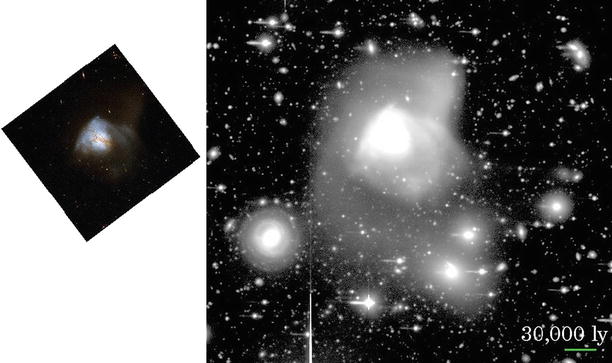
Fig. 1.15
Arp 220 is the most luminous object in the
local Universe. Originally cataloged as a peculiar galaxy, the
infrared satellite IRAS later discovered its enormous luminosity
( ) in the infrared (IR). Arp
220 is the prototype of ultra-luminous infrared galaxies (ULIRGs).
The left panel shows a
near-IR image taken with the Hubble Space Telescope (HST). The
right panel shows a
spectacular image taken with the Subaru telescope on Mauna Kea; it
unveils the structure of this object. With two colliding spiral
galaxies in the center of Arp 220, the disturbances in the
interstellar medium caused by this collision trigger a starburst.
Dust in the galaxy absorbs most of the ultra-violet (UV) radiation
from the young hot stars and re-emits it in the IR. Credit:
Left: Hubble Space
Telescope/NASA. Right:
Ehime University/NAOJ. ©National Astronomical Observatory of Japan,
©NAOJ, Courtesy of the National Astronomical Observatory of Japan,
and Courtesy of NAOJ
) in the infrared (IR). Arp
220 is the prototype of ultra-luminous infrared galaxies (ULIRGs).
The left panel shows a
near-IR image taken with the Hubble Space Telescope (HST). The
right panel shows a
spectacular image taken with the Subaru telescope on Mauna Kea; it
unveils the structure of this object. With two colliding spiral
galaxies in the center of Arp 220, the disturbances in the
interstellar medium caused by this collision trigger a starburst.
Dust in the galaxy absorbs most of the ultra-violet (UV) radiation
from the young hot stars and re-emits it in the IR. Credit:
Left: Hubble Space
Telescope/NASA. Right:
Ehime University/NAOJ. ©National Astronomical Observatory of Japan,
©NAOJ, Courtesy of the National Astronomical Observatory of Japan,
and Courtesy of NAOJ
 ) in the infrared (IR). Arp
220 is the prototype of ultra-luminous infrared galaxies (ULIRGs).
The left panel shows a
near-IR image taken with the Hubble Space Telescope (HST). The
right panel shows a
spectacular image taken with the Subaru telescope on Mauna Kea; it
unveils the structure of this object. With two colliding spiral
galaxies in the center of Arp 220, the disturbances in the
interstellar medium caused by this collision trigger a starburst.
Dust in the galaxy absorbs most of the ultra-violet (UV) radiation
from the young hot stars and re-emits it in the IR. Credit:
Left: Hubble Space
Telescope/NASA. Right:
Ehime University/NAOJ. ©National Astronomical Observatory of Japan,
©NAOJ, Courtesy of the National Astronomical Observatory of Japan,
and Courtesy of NAOJ
) in the infrared (IR). Arp
220 is the prototype of ultra-luminous infrared galaxies (ULIRGs).
The left panel shows a
near-IR image taken with the Hubble Space Telescope (HST). The
right panel shows a
spectacular image taken with the Subaru telescope on Mauna Kea; it
unveils the structure of this object. With two colliding spiral
galaxies in the center of Arp 220, the disturbances in the
interstellar medium caused by this collision trigger a starburst.
Dust in the galaxy absorbs most of the ultra-violet (UV) radiation
from the young hot stars and re-emits it in the IR. Credit:
Left: Hubble Space
Telescope/NASA. Right:
Ehime University/NAOJ. ©National Astronomical Observatory of Japan,
©NAOJ, Courtesy of the National Astronomical Observatory of Japan,
and Courtesy of NAOJ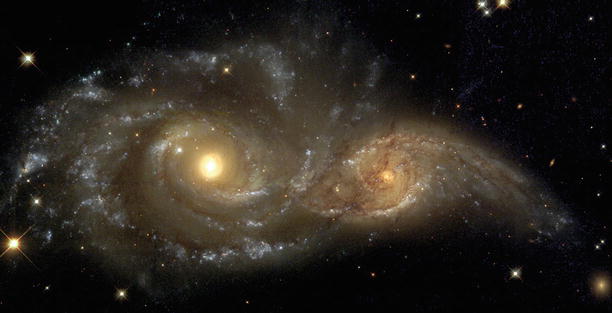
Fig. 1.16
Two spiral galaxies interacting with each
other. NGC 2207 (on the left) and IC 2163 are not only close
neighbors in projection: the strong gravitational tidal interaction
they are exerting on each other is clearly visible in the
pronounced tidal arms, particularly visible to the right of the
right-hand galaxy. Furthermore, a bridge of stars is seen to
connect these two galaxies, also due to tidal gravitational forces.
This image was taken with the Hubble Space Telescope. Credit: The
Hubble Heritage Project, STScI, NASA
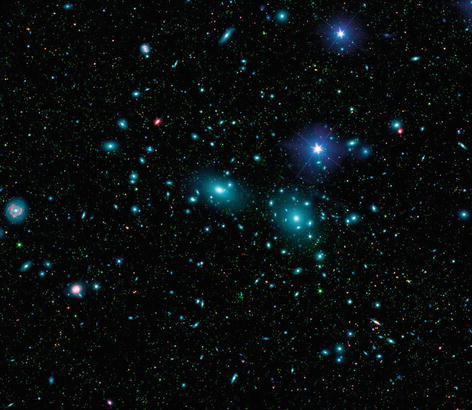
Fig. 1.17
The Coma cluster of galaxies, at a distance
of roughly 90 Mpc from us, is the closest massive regular cluster
of galaxies. Almost all brighter objects visible in this image of
the central region of Coma are galaxies associated with the
cluster—Coma contains more than a 1000 luminous galaxies. This
images is a color composite made from optical data from the Sloan
Digital Sky Survey (SDSS), shown in blue, and infrared data from the
Spitzer Space Telescope, shown in red and green, for the longer and shorter
wavelength, respectively. Credit: NASA/JPL-Caltech/GSFC/SDSS
Spiral galaxies still form stars today, indeed
star formation is a common phenomenon in galaxies. In addition,
there are galaxies with a considerably higher star-formation rate
than ‘normal’ spirals. These galaxies are undergoing a burst of
star formation and are thus known as starburst galaxies. Their
star-formation rates are typically between 10 and  , whereas our Milky Way
gives birth to about 2M
⊙∕yr of new stars. This vigorous star formation often
takes place in localized regions, e.g., in the vicinity of the
center of the respective galaxy. Starbursts are substantially
affected, if not triggered, by disturbances in the gravitational
field of the galaxy, such as those caused by galaxy interactions.
Such starburst galaxies (see Fig. 1.15) can be extremely
luminous in the far-infrared (FIR); they emit up to 98 % of their
total luminosity in this part of the spectrum. This happens by dust
emission: dust in these galaxies absorbs a large proportion of the
energetic UV radiation produced by the massive stars in the
star-formation region, thereby heats up, and then re-emits this
energy in the form of thermal radiation in the FIR.
, whereas our Milky Way
gives birth to about 2M
⊙∕yr of new stars. This vigorous star formation often
takes place in localized regions, e.g., in the vicinity of the
center of the respective galaxy. Starbursts are substantially
affected, if not triggered, by disturbances in the gravitational
field of the galaxy, such as those caused by galaxy interactions.
Such starburst galaxies (see Fig. 1.15) can be extremely
luminous in the far-infrared (FIR); they emit up to 98 % of their
total luminosity in this part of the spectrum. This happens by dust
emission: dust in these galaxies absorbs a large proportion of the
energetic UV radiation produced by the massive stars in the
star-formation region, thereby heats up, and then re-emits this
energy in the form of thermal radiation in the FIR.
 , whereas our Milky Way
gives birth to about 2M
⊙∕yr of new stars. This vigorous star formation often
takes place in localized regions, e.g., in the vicinity of the
center of the respective galaxy. Starbursts are substantially
affected, if not triggered, by disturbances in the gravitational
field of the galaxy, such as those caused by galaxy interactions.
Such starburst galaxies (see Fig. 1.15) can be extremely
luminous in the far-infrared (FIR); they emit up to 98 % of their
total luminosity in this part of the spectrum. This happens by dust
emission: dust in these galaxies absorbs a large proportion of the
energetic UV radiation produced by the massive stars in the
star-formation region, thereby heats up, and then re-emits this
energy in the form of thermal radiation in the FIR.
, whereas our Milky Way
gives birth to about 2M
⊙∕yr of new stars. This vigorous star formation often
takes place in localized regions, e.g., in the vicinity of the
center of the respective galaxy. Starbursts are substantially
affected, if not triggered, by disturbances in the gravitational
field of the galaxy, such as those caused by galaxy interactions.
Such starburst galaxies (see Fig. 1.15) can be extremely
luminous in the far-infrared (FIR); they emit up to 98 % of their
total luminosity in this part of the spectrum. This happens by dust
emission: dust in these galaxies absorbs a large proportion of the
energetic UV radiation produced by the massive stars in the
star-formation region, thereby heats up, and then re-emits this
energy in the form of thermal radiation in the FIR.1.2.5 Voids, clusters of galaxies, and dark matter
The likelihood of galaxies to interact
(Fig. 1.16)
is enhanced by the fact that galaxies are not randomly distributed
in space. The projection of galaxies on the celestial sphere, for
instance, shows a distinct structure. In addition, measuring the
distances of galaxies allows a determination of their
three-dimensional distribution. One finds a strong correlation of
the galaxy positions. There are regions in space that have a very
high galaxy density, but also regions where nearly no galaxies are
seen at all. The latter are called voids. Such voids can have diameters of
up to 30h
−1Mpc.
Clusters of
galaxies are gravitationally bound systems of a hundred or
more galaxies in a volume of diameter ∼ 2 h −1Mpc. Clusters
predominantly contain early-type galaxies, so there is not much
star formation taking place any more. Some clusters of galaxies
seem to be rather circular in projection, others have a highly
elliptical or irregular distribution of galaxies; some even have
more than one center. The cluster of galaxies closest to us is the
Virgo cluster, at a distance of ∼ 18 Mpc; it is a cluster with an
irregular galaxy distribution. The closest regular cluster is Coma,
at a distance of ∼ 90 Mpc.6 Coma (Fig. 1.17) contains about 1000
luminous galaxies, of which 85 % are early-type galaxies.
In 1933, Fritz Zwicky measured the radial
velocities of the galaxies in Coma and found that their
distribution around the mean has a dispersion of about 1000 km∕s.
From the total luminosity of all its galaxies the mass of the
cluster can be estimated. If the stars in the cluster galaxies have
an average mass-to-light ratio (M∕L) similar to that of our Sun, we would
conclude  . However, stars in
early-type galaxies are on average slightly less massive than the
Sun and thus have a slightly higher M∕L.7 Thus, the above mass estimate needs
to be increased by a factor of ∼ 10.
. However, stars in
early-type galaxies are on average slightly less massive than the
Sun and thus have a slightly higher M∕L.7 Thus, the above mass estimate needs
to be increased by a factor of ∼ 10.
 . However, stars in
early-type galaxies are on average slightly less massive than the
Sun and thus have a slightly higher M∕L.7 Thus, the above mass estimate needs
to be increased by a factor of ∼ 10.
. However, stars in
early-type galaxies are on average slightly less massive than the
Sun and thus have a slightly higher M∕L.7 Thus, the above mass estimate needs
to be increased by a factor of ∼ 10.Zwicky then estimated the mass of the cluster by
multiplying the luminosity of its member galaxies with the
mass-to-light ratio. From this mass and the size of the cluster, he
could then estimate the velocity that a galaxy needs to have in
order to escape from the gravitational field of the cluster—the
escape velocity. He found that the characteristic peculiar velocity
of cluster galaxies (i.e., the velocity relative to the mean
velocity) is substantially larger than this escape velocity. In
this case, the galaxies of the cluster would fly apart on a
time-scale of about 109 yr—the time it takes a galaxy to
cross through the cluster once—and, consequently, the cluster would
dissolve. However, since Coma seems to be a relaxed cluster, i.e.,
it is in equilibrium and thus its age is definitely larger than the
dynamical time scale of 109 yr, Zwicky concluded that
the Coma cluster contains significantly more mass than the sum of
the masses of its galaxies. Using the virial theorem8 he was able to estimate the mass
of the cluster from the velocity distribution of the galaxies. This
was the first clear indicator of the existence of dark
matter.
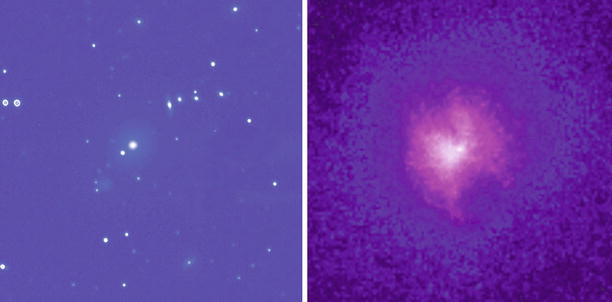
Fig. 1.18
The Hydra A cluster of galaxies. The
left-hand figure shows an
optical image, the one on the
right an image taken with the X-ray satellite Chandra. The
cluster has a redshift of z ≈ 0. 054 and is thus located at a
distance of about 250 Mpc. The X-ray emission originates from gas
at a temperature of 40 × 106K which fills the space
between the cluster galaxies. In the center of the cluster, the gas
is cooler by about 15 %. Credit: Optical: B. McNamara, La Palma;
X-ray: NASA/CXC/SAO
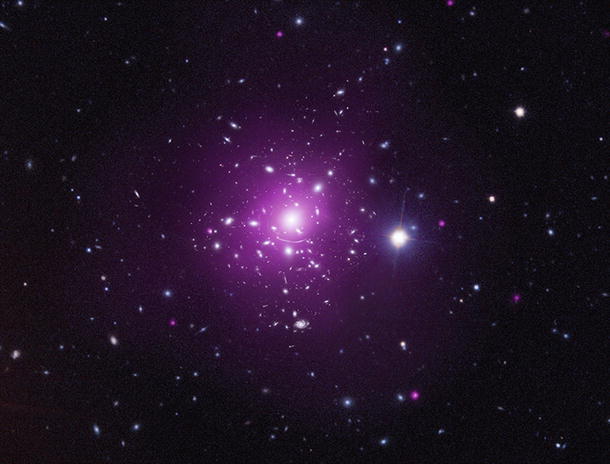
Fig. 1.19
The cluster of galaxies Abell 383, as seen
in optical light, superposed by an image taken at X-ray energies
(purple) with the Chandra
satellite observatory. The space between the galaxies is filled by
a hot gas, with temperature of about 50 million degrees, which
emits the energetic X-ray radiation. The cluster is at a redshift
of z = 0. 19, corresponding
to a distance of about 800 Mpc, and has an estimated mass of
 . Credit: X-ray:
NASA/CXC/Caltech/A. Newman et al./Tel Aviv/A. Morandi
& M. Limousin; Optical: NASA/STScI, ESO/VLT, SDSS
. Credit: X-ray:
NASA/CXC/Caltech/A. Newman et al./Tel Aviv/A. Morandi
& M. Limousin; Optical: NASA/STScI, ESO/VLT, SDSS
 . Credit: X-ray:
NASA/CXC/Caltech/A. Newman et al./Tel Aviv/A. Morandi
& M. Limousin; Optical: NASA/STScI, ESO/VLT, SDSS
. Credit: X-ray:
NASA/CXC/Caltech/A. Newman et al./Tel Aviv/A. Morandi
& M. Limousin; Optical: NASA/STScI, ESO/VLT, SDSSX-ray satellites later revealed that clusters of
galaxies are strong sources of X-ray radiation. They contain hot
gas, with temperatures ranging from 107 up to
108 K (Fig. 1.18). This gas temperature is another measure
for the depth of the cluster’s potential well, since the hotter the
gas is, the deeper the potential well has to be to prevent the gas
from escaping via evaporation. Mass estimates based on the X-ray
temperature result in values that are comparable to those from the
velocity dispersion of the cluster galaxies. Whereas the X-ray
emitting gas provides a further mass component of ordinary,
baryonic matter—in fact, the X-ray emitting gas contains more mass
than the stars in the cluster galaxies—the total mass of clusters
exceeds that of stars and gas by a factor of about five, thus
clearly confirming the hypothesis of the existence of dark matter
in clusters (Fig. 1.19). A third method for determining cluster
masses, the so-called gravitational lensing effect, utilizes the
fact that light is deflected in a gravitational field. The angle
through which light rays are bent due to the presence of a massive
object depends on the mass of that object. From observation and
analysis of the gravitational lensing effect in clusters of
galaxies, cluster masses are derived that are in agreement with
those from the two other methods. Therefore, clusters of galaxies
are a second class of cosmic objects whose mass is dominated by
dark matter.
Clusters of galaxies are cosmologically young
structures. Their dynamical time-scale, i.e., the time in which the
mass distribution in a cluster settles into an equilibrium state,
is estimated as the time it takes a member galaxy to fully cross
the cluster once. With a characteristic velocity of v ∼ 1000 km∕s and a diameter of
2R ∼ 2 Mpc one thus finds
 As we will later see, the Universe is about 14 × 109 yr
old. During this time galaxies have not had a chance to cross the
cluster many times. Therefore, clusters still contain, at least in
principle, information about their initial state. Most clusters
have not had the time to fully relax and evolve into a state of
equilibrium that would be largely independent of their initial
conditions. Comparing this with the time taken for the Sun to
rotate around the center of the Milky Way—about 2 ×
108 yr—galaxies thus have had plenty of time to reach
their state of equilibrium.
As we will later see, the Universe is about 14 × 109 yr
old. During this time galaxies have not had a chance to cross the
cluster many times. Therefore, clusters still contain, at least in
principle, information about their initial state. Most clusters
have not had the time to fully relax and evolve into a state of
equilibrium that would be largely independent of their initial
conditions. Comparing this with the time taken for the Sun to
rotate around the center of the Milky Way—about 2 ×
108 yr—galaxies thus have had plenty of time to reach
their state of equilibrium.

(1.9)
Besides massive clusters of galaxies there are
also galaxy groups, which sometimes contain only a few luminous
galaxies. In fact, the number density of groups is far larger than
that of clusters. Our Milky Way is part of such a group, the Local
Group, which also contains M31 ( Andromeda), a second luminous
spiral galaxy besides the Milky Way, as well as some far less
luminous galaxies such as the Magellanic Clouds. Some groups of
galaxies are very compact, i.e., their galaxies are confined within
a very small volume (Fig. 1.20). Interactions between these galaxies
cause the lifetimes of many such groups to be much smaller than the
age of the Universe, and the galaxies in such groups will
merge.
1.2.6 World models and the thermal history of the Universe
Quasars, clusters of galaxies, and nowadays even
single galaxies are also found at very high redshifts where the
simple form of the Hubble law (1.2) is no longer valid.
It is therefore necessary to generalize the distance-redshift
relation. This requires considering world models as a whole, which
are also called cosmological models. The dominant force in the
Universe is gravitation. On the one hand, weak and strong
interactions both have an extremely small (sub-atomic) range, and
on the other hand, electromagnetic interactions do not play a role
on large scales since the matter in the Universe is on average
electrically neutral. Indeed, if it was not, currents would
immediately flow to balance net charge densities. The accepted
theory of gravitation is the theory of General Relativity (GR),
formulated by Albert Einstein in 1915.
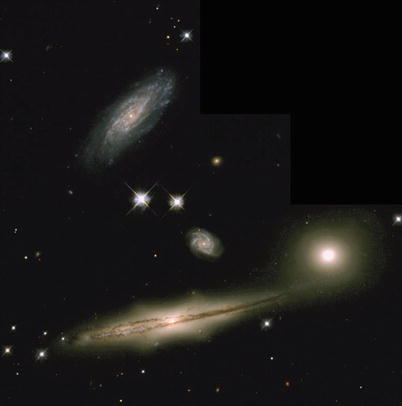
Fig. 1.20
The galaxy group HCG87 belongs to the class
of so-called compact groups. In this HST image we can see three
massive galaxies belonging to this group: an edge-on spiral in the
lower part of the image, an
elliptical galaxy to the lower
right, and another spiral in the upper part. The small spiral in the
center is a background object and therefore does not belong to the
group. The two lower galaxies have an active galactic nucleus,
whereas the upper spiral seems to be undergoing a phase of star
formation. The galaxies in this group are so close together that in
projection they appear to touch. Between the galaxies, gas streams
can be detected. The galaxies are disturbing each other, which
could be the cause of the nuclear activity and star formation. The
galaxies are bound in a common gravitational potential and will
heavily interfere and presumably merge on a cosmologically small
time scale, which means in only a few orbits, with an orbit taking
about 108 yr. Such merging processes are of utmost
importance for the evolution of the galaxy population. Credit:
STScI and the Hubble Heritage Project
Based on the two postulates that (1) our place in
the Universe is not special, and thus not distinguished from other
locations and that (2) the distribution of matter around us is
isotropic, at least on large scales, one can construct homogeneous
and isotropic world models (so-called Friedmann–Lemaître models)
that obey the laws of General Relativity. Expanding world models
that contain the Hubble expansion result from this theory
naturally. Essentially, these models are characterized by three
parameters:
-
the current expansion rate of the Universe, i.e., the Hubble constant H 0;
-
the current mean matter density of the Universe ρ m, often parametrized by the dimensionless density parameter of matter,
 (1.10)
(1.10) -
and the density of the so-called vacuum energy, described by the cosmological constant Λ or by the corresponding density parameter of the vacuum
 (1.11)
(1.11)
The cosmological constant was originally
introduced by Einstein to allow stationary world models within GR.
After the discovery of the Hubble expansion he is quoted to have
called the introduction of Λ into his equations his greatest
blunder. In quantum mechanics Λ attains a different interpretation,
related to an energy density of the vacuum.
The values of the cosmological parameters are
known quite accurately today (see Chap. 8), with values of Ω m ≈ 0. 3 and Ω Λ ≈ 0. 7. The discovery of a
non-vanishing Ω
Λ came
completely unexpectedly. To date, all attempts have failed to
compute a reasonable value for Ω Λ from quantum mechanics. By that
we mean a value which has the same order-of-magnitude as the one we
derive from cosmological observations. In fact, simple and
plausible estimates lead to a value of Λ that is ∼ 10120 times
larger than that obtained from observation, a tremendously bad
estimate indeed. This huge discrepancy is probably one of the
biggest challenges in fundamental physics today.
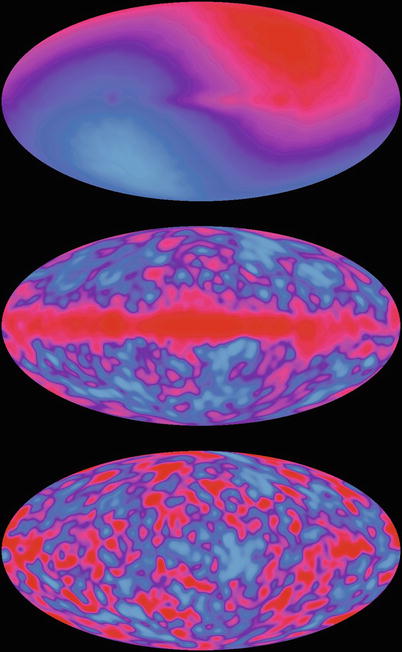
Fig. 1.21
Temperature distribution of the cosmic
microwave background on the sky as measured by the COBE satellite.
The top image shows a
dipole distribution; it originates from the Earth’s motion relative
to the restframe of the CMB. Our Solar System moves at a speed of
369 km∕s relative to that system, which leads to a dipole
anisotropy with an amplitude of  due
to the Doppler effect. If this dipole contribution is subtracted,
we get the map in the
middle which clearly shows the emission from the Galactic
disk. Since this emission has a different spectral energy
distribution (it is not a blackbody of T ∼ 3 K), it can also be subtracted to
get the temperature map at the
bottom. These are the primordial fluctuations of the CMB,
with an amplitude of about
due
to the Doppler effect. If this dipole contribution is subtracted,
we get the map in the
middle which clearly shows the emission from the Galactic
disk. Since this emission has a different spectral energy
distribution (it is not a blackbody of T ∼ 3 K), it can also be subtracted to
get the temperature map at the
bottom. These are the primordial fluctuations of the CMB,
with an amplitude of about  . Credit:
COBE/DRM team, NASA
. Credit:
COBE/DRM team, NASA
 due
to the Doppler effect. If this dipole contribution is subtracted,
we get the map in the
middle which clearly shows the emission from the Galactic
disk. Since this emission has a different spectral energy
distribution (it is not a blackbody of T ∼ 3 K), it can also be subtracted to
get the temperature map at the
bottom. These are the primordial fluctuations of the CMB,
with an amplitude of about
due
to the Doppler effect. If this dipole contribution is subtracted,
we get the map in the
middle which clearly shows the emission from the Galactic
disk. Since this emission has a different spectral energy
distribution (it is not a blackbody of T ∼ 3 K), it can also be subtracted to
get the temperature map at the
bottom. These are the primordial fluctuations of the CMB,
with an amplitude of about  . Credit:
COBE/DRM team, NASA
. Credit:
COBE/DRM team, NASAAccording to the Friedmann–Lemaître models, the
Universe used to be smaller and hotter in the past, and it has
continuously cooled down in the course of expansion. We are able to
trace back the cosmic expansion under the assumption that the known
laws of physics were also valid in the past. From that we get the
Big Bang model of the Universe, according to which our Universe has
evolved out of a very dense and very hot state, the so-called
Big Bang. The Big Bang
marks the beginning of the Universe, at least as far as physics can
describe it, and is taken to be the origin of cosmic time. This
world model makes a number of predictions that have been verified
convincingly:
1.
About 1/4 of the baryonic matter in the Universe
should consist of helium which formed about 3 min after the Big
Bang, while most of the rest consists of hydrogen. This is indeed
the case: the mass fraction of helium in metal-poor objects, whose
chemical composition has not been significantly modified by
processes of stellar evolution, is about 24 %.
2.
From the exact fraction of helium one can derive
the number of neutrino families—the more neutrino species that
exist, the larger the fraction of helium will be. From this, it was
derived in 1981 that there are three kinds of neutrinos. This
result was later confirmed by particle accelerator
experiments.
3.
Thermal radiation from the hot early phase of the
Universe should still be measurable today. Predicted in 1946 by
George Gamow, it was discovered by Arno Penzias and Robert Wilson
in 1965. The corresponding photons have propagated freely after the
Universe cooled down to about 3000 K and the plasma
constituents—atomic nuclei and electrons—combined to neutral atoms,
an epoch called recombination. As a result of cosmic
expansion, this radiation has cooled down to about T 0 ≈ 2. 73 K. This
microwave radiation is observed to be nearly perfectly isotropic,
once we subtract the radiation which is emitted locally by the
Milky Way (see Fig. 1.21). Indeed, measurements from the COBE
satellite showed that the cosmic microwave background (CMB) is the
most accurate blackbody spectrum ever measured.
4.
Today’s structures in the Universe have evolved
out of very small density fluctuations in the early cosmos. The
seeds of structure formation must have already been present in the
very early phases of cosmic evolution. These density fluctuations
should also be visible as small temperature fluctuations in the
microwave background emitted about 380 000 years after the Big Bang
at the epoch of recombination. In fact, COBE was the first to
observe these predicted anisotropies (see Fig. 1.21). Later experiments,
especially the WMAP and Planck satellites, observed the structure
of the microwave background at much improved angular resolution and
verified the theory of structure formation in the Universe in
detail (see Sect. 8.6).
With these predictions so impressively confirmed,
in this book we will exclusively consider this cosmological model;
currently there is no competing model of the Universe that could
explain these very basic cosmological observations in a natural
way. In addition, this model does not seem to contradict any
fundamental observation in cosmology. However, as the existence of
a non-vanishing vacuum energy density shows, together with a matter
density ρ m that
is about six times the mean baryon density in the Universe (which
can be derived from the abundance of the chemical elements formed
in the Big Bang), the physical nature of about 95 % of the content
of our Universe is not yet understood.
Most of the CMB photons we receive today had
their last physical interaction with matter when the Universe was
about 3. 8 × 105 yr old. Also, the most distant galaxies
and quasars known today (at z ∼ 7) are strikingly young—we see them
at a time when the Universe was less than a tenth of its current
age . The exact relation between the age of the Universe at the
time of the light emission and the redshift depends on the
cosmological parameters H
0, Ω
m, and Ω
Λ . In the
special case that Ω
m = 1 and Ω
Λ = 0, called
the Einstein–de Sitter
model, one obtains
 In particular, the age of the Universe today (i.e., at z = 0) in this model is
In particular, the age of the Universe today (i.e., at z = 0) in this model is
 The Einstein–de Sitter (EdS) model is the simplest world model and
we will sometimes use it as a reference, despite the fact the our
Universe does not follow the EdS model, since Ω m < 1 and Ω Λ > 0. However, due to its
mathematical simplicity, it is often convenient to obtain rough
estimates within this model. The mean density of the Universe in
the EdS model is
The Einstein–de Sitter (EdS) model is the simplest world model and
we will sometimes use it as a reference, despite the fact the our
Universe does not follow the EdS model, since Ω m < 1 and Ω Λ > 0. However, due to its
mathematical simplicity, it is often convenient to obtain rough
estimates within this model. The mean density of the Universe in
the EdS model is
 hence it is really, really small.
hence it is really, really small.

(1.12)

(1.13)

(1.14)
1.2.7 Structure formation and galaxy evolution
The low amplitude of the CMB anisotropies implies
that the inhomogeneities must have been very small at the epoch of
recombination, whereas today’s Universe features very large density
fluctuations, at least on scales of clusters of galaxies. Hence,
the density field of the cosmic matter must have evolved. This
structure evolution occurs because of gravitational instability ,
in that an overdense region will expand more slowly than the mean
Universe due to its self-gravity. Therefore, any relative
overdensity becomes amplified in time. The growth of density
fluctuations in time will then cause the formation of large-scale
structures, and the gravitational instability is also responsible
for the formation of galaxies and clusters. Our world model
sketched above predicts the abundance of galaxy clusters as a
function of redshift, which can be compared with the observed
cluster counts. This comparison can then be used to determine
cosmological parameters.
Another essential conclusion from the smallness
of the CMB anisotropies is the existence of dark matter on cosmic
scales. The major fraction of cosmic matter is dark matter. The
baryonic contribution to the matter density is ≲ 20 % and to the
total energy density ≲ 5 %. The energy density of the Universe is
dominated by the vacuum energy.
Unfortunately, the spatial distribution of dark
matter on large scales is not directly observable. We only observe
galaxies or, more precisely, their stars and gas. One might expect
that galaxies would be located preferentially where the dark matter
density is high. However, it is by no means clear that local
fluctuations of the galaxy number density are strictly proportional
to the density fluctuations of dark matter. The relation between
the dark and luminous matter distributions is currently only
approximately understood.
Eventually, this relation has to result from a
detailed understanding of galaxy formation and evolution. Locations
with a high density of dark matter can support the formation of
galaxies. Thus we will have to examine how galaxies form and why
there are different kinds of galaxies. In other words, what decides
whether a forming galaxy will become an elliptical or a spiral?
This question has not been definitively answered yet, but it is
supposed that ellipticals can form only by the merging of galaxies.
Indeed, the standard model of the Universe predicts that small
galaxies will form first; larger galaxies will be formed later
through the ongoing merger of smaller ones.
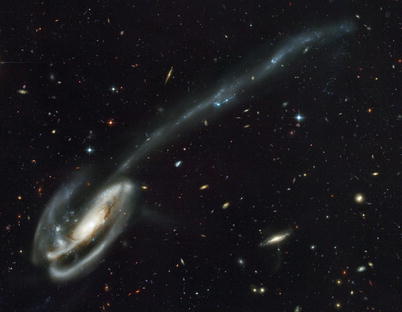
Fig. 1.22
Galaxy evolution caught in the act: The
Tadpole galaxy (also called Arp 188) shows a ∼ 90 kpc long tail.
Most likely, this spiral galaxy collided with a smaller galaxy some
time in the past, which ripped part of its matter away from the
main body of the galaxy. Inside the tail, clusters of newly formed
stars are visible. Clearly, this galaxy will have changed from its
earlier state after it becomes settled again. Credit: H. Ford
(JHU), M. Clampin (STScI), G. Hartig (STScI), G. Illingworth
(UCO/Lick), ACS Science Team, ESA, NASA
The evolution of galaxies can actually be
observed directly. Galaxies at high redshift (i.e., cosmologically
young galaxies) are in general smaller and bluer, and the
star-formation rate was significantly higher at earlier times than
it is today. The change in the mean color of galaxies as a function
of redshift can be understood as a combination of changes in the
star formation processes and an aging of the stellar population.
Also, galaxy collisions which can be directly observed in the local
Universe (Fig. 1.22; see also Fig. 1.16) have a strong
impact on individual galaxies and need to be considered in models
of galaxy evolution.
1.2.8 Cosmology as a triumph of the human mind
Cosmology, extragalactic astronomy, and
astrophysics as a whole are a heroic undertaking of the human mind
and a triumph of physics. To understand the Universe we apply
physical laws that were found empirically under completely
different circumstances. All the known laws of physics were derived
‘today’ and, except for General Relativity, are based on
experiments on a laboratory scale or, at most, on observations in
the Solar System, such as Kepler’s laws which formed the foundation
for the Newtonian theory of gravitation. Is there any a priori
reason to assume that these laws are also valid in other regions of
the Universe or at completely different times? However, this is
apparently indeed the case: nuclear reactions in the early Universe
seem to obey the same laws of strong interaction that are measured
today in our laboratories, since otherwise the agreement of the
prediction of a 25 % helium mass fraction from nuclear reactions in
the first minutes of our Universe with the observed helium
abundance would be a pure coincidence. Quantum mechanics,
describing the wavelengths of atomic transitions, also seems to be
valid at very large distances—since even the most distant objects
show emission lines in their spectra with frequency ratios (which
are described by the laws of quantum mechanics) identical to those
in nearby objects. In fact, cosmologists can put very tight upper
limits on a possible variation of the ‘constants’ of nature with
time, such as the fine-structure constant or the electron to proton
mass ratio.
By far the greatest achievement is General
Relativity. It was originally formulated by Albert Einstein since
his special theory of relativity did not allow him to incorporate
the laws of Newtonian gravity. No empirical findings were known at
that time (1915) which would not have been explained by the
Newtonian theory of gravity. Nevertheless, Einstein developed a
totally new theory of gravitation for purely theoretical reasons.
The first success of this theory was the correct description of the
gravitational deflection of light by the Sun, measured in 1919, and
of the perihelion rotation of Mercury.9 His theory permits a description of
the expanding Universe, which became necessary after Hubble’s
discovery in 1928. Only with the help of this theory can we
reconstruct the history of the Universe back into the past. Today
this history seems to be well understood up to the time when the
Universe was about 10−6 s old and had a temperature of
about 1013 K. Particle physics models allow an
extrapolation to even earlier epochs.
The cosmological predictions discussed above are
based on General Relativity describing an expanding Universe,
therefore providing a test of Einstein’s theory. On the other hand,
General Relativity also describes much smaller systems and with
much stronger gravitational fields, such as neutron stars and black
holes. With the discovery of a binary system consisting of two
neutron stars, the binary pulsar PSR 1913+16, in the last ∼ 40 yr
very accurate tests of General Relativity have become possible. For
example, the observed perihelion rotation in this binary system and
the shrinking of the binary orbit over time due to the radiation of
energy by gravitational waves is extremely accurately described by
General Relativity. Together, General Relativity has been
successfully tested on length-scales from 1011cm (the
characteristic scale of the binary pulsar) to 1028cm
(the size of the visible Universe), that is over more than
1017 orders of magnitude—an impressive result
indeed!
1.2.9 Astrophysics & Physics
Exploring the laws of gravity by astronomical
observations in the Solar System and beyond is just one example for
the close connection between physics and astronomy. As the word
‘astrophysics’ implies, the
science of the Universe has become an integral part of physics.
Astrophysics and cosmology not only apply the laws of physics to
interpret and understand the cosmic objects like stars, galaxies
and black holes, but also have led to discoveries concerning
fundamental physics. A few examples should illustrate that point.
-
Measuring the flux of neutrinos from the Sun, which are produced by nuclear fusion in the Solar center to generate the Solar luminosity, it was found that the observed neutrino rate is only half of what was expected. The solution of this Solar neutrino problem led to the discovery of neutrino oscillations, disclosing a fundamental property of these weakly interacting particles, requiring them to have a finite rest mass (see Sect. 4.4.6), and providing clear evidence for the incompleteness of the Standard Model of elementary particles.
-
The fact that carbon has a large abundance in the Universe led Frey Hoyle in 1952 to suspect that there should be a particular excited state of this nucleus in resonance with energy levels of beryllium and helium, to enable the formation of carbon through nuclear fusion in stellar interiors. This previously unknown state, essential for the occurrence of the so-called triple-alpha process, was later on found in experiments.
-
Much of the development in the field of plasma physics was driven by astrophysicists in order to understand the behavior of plasmas in cosmic objects—ranging from the Sun (e.g., the occurrence of sunspots, the Solar corona) to the interplanetary space filled with the Solar wind and its interaction with the Earth’s magnetosphere, to the impact of magnetic fields on star-forming regions, to the formation of relativistic jets in active galactic nuclei.
Arguably the largest impact astrophysics has on
other branches of physics today is related to the finding that the
Universe is dominated by dark matter and dark energy—there is no
evidence for the existence of these new forms of energy apart from
astronomical observations. We will come back to that theme
repeatedly in the course of this book.
However, there is one important difference
between astrophysics and other branches of physics: we cannot do
experiments with the subjects of interest, we cannot prepare the
system is a way which allows a clean measurement under controlled
external conditions, and repeat the measurement with changing
conditions. We can only observe how our objects behave, how
different objects of the same kind are similar—or different—in
their behavior, and draw conclusions from it.
1.3 The tools of extragalactic astronomy
Extragalactic sources—galaxies, quasars, clusters
of galaxies—are at large distances. This means that in general they
appear to be faint even if they are intrinsically luminous. They
are also seen to have a very small angular size despite their
possibly large linear extent. In fact, just three extragalactic
sources are visible to the naked eye: the Andromeda galaxy (M31)
and the Large and Small Magellanic Clouds. Thus for extragalactic
astronomy, telescopes are needed that have large apertures (photon
collecting area) and a high angular resolution. This applies to all
wavebands, from radio astronomy to gamma ray astronomy.
The properties of astronomical telescopes and
their instruments can be judged by different criteria, and we will
briefly describe the most important ones. The sensitivity specifies how dim a source
can be and still be observable in a given integration time. The
sensitivity depends on the aperture of the telescope as well as on
the efficiency of the instrument and the sensitivity of the
detector. The sensitivity of optical telescopes, for instance, was
increased by a large factor when CCDs replaced photographic plates
as detectors in the early 1980s. The sensitivity also depends on
the sky background, i.e., the brightness of the sky caused by
non-astronomical sources. Artificial light in inhabited regions has
forced optical telescopes to retreat into more and more remote
areas of the world where light
pollution is minimized. Radio astronomers have similar
problems caused by radio emission from the telecommunication
infrastructure of modern civilization. The angular resolution of a telescope
specifies down to which angular separation two sources in the sky
can still be separated by the detector. For diffraction-limited
observations like those made with radio telescopes or space-born
telescopes, the angular resolution Δ θ is limited by the diameter
D of the telescope. For a
wavelength λ one has
 . For optical and
near-infrared observations from the ground, the angular resolution
is in general limited by turbulence in the atmosphere, which
explains the choice of high mountain tops as sites for optical
telescopes. These atmospheric turbulences cause, due to
scintillation, the smearing of the images of astronomical sources,
an effect that is called seeing . In interferometry, where one
combines radiation detected by several telescopes, the angular
resolution is limited by the spatial separation of the telescopes.
The spectral resolution of
an instrument specifies its capability to separate different
wavelengths. The throughput
of a telescope/instrument system is of particular importance in
large sky surveys. For instance, the efficiency of spectroscopic
surveys depends, in addition to the aperture of the telescope, on
the number of spectra that can be observed simultaneously. Special
multiplex spectrographs have been constructed for such tasks.
Likewise, the efficiency of photometric surveys depends on the
telescope’s diameter and the region of sky that can be observed
simultaneously, i.e., the field-of-view of the camera. Finally, the
efficiency of observations also depends on factors like the number
of clear nights at an astronomical site, the fraction of an
observing night in which actual science data is taken, the fraction
of time an instrument cannot be used due to technical problems, the
stability of the instrumental set-up (which determines the time
required for calibration measurements), and many other such
aspects.
. For optical and
near-infrared observations from the ground, the angular resolution
is in general limited by turbulence in the atmosphere, which
explains the choice of high mountain tops as sites for optical
telescopes. These atmospheric turbulences cause, due to
scintillation, the smearing of the images of astronomical sources,
an effect that is called seeing . In interferometry, where one
combines radiation detected by several telescopes, the angular
resolution is limited by the spatial separation of the telescopes.
The spectral resolution of
an instrument specifies its capability to separate different
wavelengths. The throughput
of a telescope/instrument system is of particular importance in
large sky surveys. For instance, the efficiency of spectroscopic
surveys depends, in addition to the aperture of the telescope, on
the number of spectra that can be observed simultaneously. Special
multiplex spectrographs have been constructed for such tasks.
Likewise, the efficiency of photometric surveys depends on the
telescope’s diameter and the region of sky that can be observed
simultaneously, i.e., the field-of-view of the camera. Finally, the
efficiency of observations also depends on factors like the number
of clear nights at an astronomical site, the fraction of an
observing night in which actual science data is taken, the fraction
of time an instrument cannot be used due to technical problems, the
stability of the instrumental set-up (which determines the time
required for calibration measurements), and many other such
aspects.
 . For optical and
near-infrared observations from the ground, the angular resolution
is in general limited by turbulence in the atmosphere, which
explains the choice of high mountain tops as sites for optical
telescopes. These atmospheric turbulences cause, due to
scintillation, the smearing of the images of astronomical sources,
an effect that is called seeing . In interferometry, where one
combines radiation detected by several telescopes, the angular
resolution is limited by the spatial separation of the telescopes.
The spectral resolution of
an instrument specifies its capability to separate different
wavelengths. The throughput
of a telescope/instrument system is of particular importance in
large sky surveys. For instance, the efficiency of spectroscopic
surveys depends, in addition to the aperture of the telescope, on
the number of spectra that can be observed simultaneously. Special
multiplex spectrographs have been constructed for such tasks.
Likewise, the efficiency of photometric surveys depends on the
telescope’s diameter and the region of sky that can be observed
simultaneously, i.e., the field-of-view of the camera. Finally, the
efficiency of observations also depends on factors like the number
of clear nights at an astronomical site, the fraction of an
observing night in which actual science data is taken, the fraction
of time an instrument cannot be used due to technical problems, the
stability of the instrumental set-up (which determines the time
required for calibration measurements), and many other such
aspects.
. For optical and
near-infrared observations from the ground, the angular resolution
is in general limited by turbulence in the atmosphere, which
explains the choice of high mountain tops as sites for optical
telescopes. These atmospheric turbulences cause, due to
scintillation, the smearing of the images of astronomical sources,
an effect that is called seeing . In interferometry, where one
combines radiation detected by several telescopes, the angular
resolution is limited by the spatial separation of the telescopes.
The spectral resolution of
an instrument specifies its capability to separate different
wavelengths. The throughput
of a telescope/instrument system is of particular importance in
large sky surveys. For instance, the efficiency of spectroscopic
surveys depends, in addition to the aperture of the telescope, on
the number of spectra that can be observed simultaneously. Special
multiplex spectrographs have been constructed for such tasks.
Likewise, the efficiency of photometric surveys depends on the
telescope’s diameter and the region of sky that can be observed
simultaneously, i.e., the field-of-view of the camera. Finally, the
efficiency of observations also depends on factors like the number
of clear nights at an astronomical site, the fraction of an
observing night in which actual science data is taken, the fraction
of time an instrument cannot be used due to technical problems, the
stability of the instrumental set-up (which determines the time
required for calibration measurements), and many other such
aspects.In the rest of this section some telescopes will
be presented that are of special relevance to extragalactic
astronomy and to which we will frequently refer throughout the
course of this book.
1.3.1 Radio telescopes
With the exception of optical wavelengths, the
Earth’s atmosphere is transparent only for very large
wavelengths—radio waves. The radio window of the atmosphere is cut
off towards lower frequencies, at about ν ∼ 10 MHz, because radiation of a
wavelength larger than λ ∼ 30 m is reflected by the Earth’s
ionosphere and therefore cannot reach the ground. Below
λ ∼ 5 mm radiation is
increasingly absorbed by oxygen and water vapor in the atmosphere,
and below about λ ∼ 0. 3 mm
ground-based observations are no longer possible.

Fig. 1.23
“Jansky’s Merry-Go-Round”. By turning the
structure in an azimuthal direction, a rough estimate of the
position of radio sources could be obtained. Credit: NRAO/AUI
Mankind became aware of cosmic radio radiation—in
the early 1930s—only when noise in radio antennas was found that
would not vanish, no matter how quiet the device was made. In order
to identify the source of this noise the AT&T Bell Labs hired
Karl Jansky, who constructed a movable antenna called “Jansky’s
Merry-Go-Round” (Fig. 1.23). After some months Jansky had identified,
besides thunderstorms, one source of interference that rose and set
every day. However, it did not follow the course of the Sun which
was originally suspected to be the source. Rather, it followed the
stars. Jansky finally discovered that the signal originated from
the direction of the center of the Milky Way. He published his
result in 1933, but this publication also marked the end of his
career as the world’s first radio astronomer.
Inspired by Jansky’s discovery, Grote Reber was
the first to carry out real astronomy with radio waves. When
AT&T refused to employ him, he built his own radio “dish” in
his garden, with a diameter of nearly 10 m. Between 1938 and 1943,
Reber compiled the first sky maps in the radio domain. Besides
strong radiation from the center of the Milky Way he also
identified sources in Cygnus and in Cassiopeia. Through Reber’s
research and publications radio astronomy became an accepted field
of science after World War II.
The largest single-dish radio telescope is the
Arecibo telescope , shown in Fig. 1.24. Due to its enormous
area, and thus high sensitivity, this telescope, among other
achievements, detected the first pulsar in a binary system, which
is used as an important test laboratory for General Relativity (see
Sect. 7.9). Also, the first extra-solar
planet, in orbit around a pulsar, was discovered with the Arecibo
telescope. For extragalactic astronomy Arecibo plays an important
role in measuring the redshifts and line widths of spiral galaxies,
both determined from the 21 cm emission line of neutral hydrogen
(see Sect. 3.4).

Fig. 1.24
With a diameter of 305 m, the Arecibo
telescope in Puerto Rico is the largest single-dish telescope in
the world; it may also be known from the James Bond movie
“GoldenEye”. The disadvantage of its construction is its lack of
steerability. Tracking of sources is only possible within narrow
limits by moving the secondary mirror. Credit: Courtesy of the
NAIC-Arecibo Observatory, a facility of the NSF
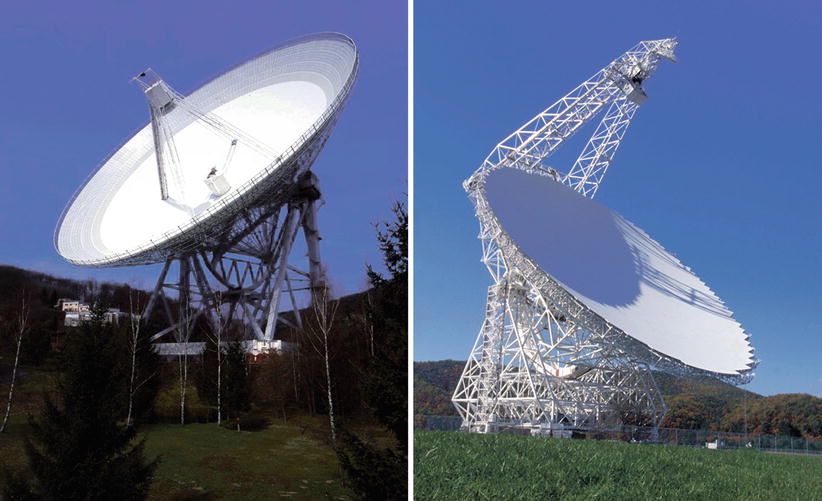
Fig. 1.25
The world’s two largest fully steerable
radio telescopes. Left: The
100 m telescope in Effelsberg. It was commissioned in 1972 and is
used in the wavelength range from 3.5 mm to 35 cm. Eighteen
different detector systems are necessary for this. Right: The Green Bank Telescope. It
does not have a rotationally symmetric mirror; one axis has a
diameter of 100 m and the other 110 m. Credit: Left: Max-Planck-Institut für
Radioastronomie. Right:
NRAO/AUI
The Effelsberg 100 m radio telescope of the
Max-Planck-Institut für Radioastronomie was, for many years, the
world’s largest fully steerable radio telescope, but since 2000
this title has been claimed by the new Green Bank Telescope (see
Fig. 1.25)
after the old one collapsed in 1988. With Effelsberg, for example,
star formation regions can be investigated. Using molecular line
spectroscopy, one can measure their densities and temperatures.
Magnetic fields also play a role in star formation, though many
details still need to be clarified. By measuring the polarized
radio flux, Effelsberg has mapped the magnetic fields of numerous
spiral galaxies. It is also used to map the neutral hydrogen
distribution in the Galaxy, its neighborhood and galaxies in the
nearby Universe, as well as for pulsar research. In addition, due
to its huge collecting area Effelsberg plays an important role in
interferometry at very long baselines (see below).
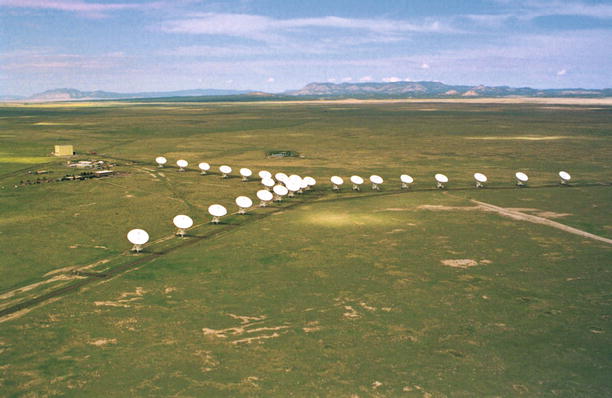
Fig. 1.26
The Very Large Array (VLA) in New Mexico
consists of 27 antennas with a diameter of 25 m each that can be
moved on rails. It is used in four different configurations that
vary in the separation of the telescopes; switching configurations
takes about 2 weeks. Credit: NRAO/AUI
Because of the long wavelength, the angular
resolution of even large radio telescopes is fairly low, compared
to optical telescopes. For this reason, radio astronomers soon
began utilizing interferometric methods, where the signals obtained
by several telescopes are correlated to get an interference
pattern. One can then reconstruct the structure of the source from
this pattern using Fourier transformation. With this method one
gets the same angular resolution (though, of course, not the same
sensitivity) as one would achieve with a single telescope of a
diameter corresponding to the maximum pair separation of the
individual telescopes used.
Following the first interferometric measurements
in England (around 1960) and the construction of the large
Westerbork Synthesis Radio Telescope in the Netherlands (around
1970), at the end of the 1970s the Very Large Array (VLA) in New
Mexico (see Fig. 1.26) began operating. With the VLA one
achieved an angular resolution in the radio domain comparable to
that of optical telescopes at that time. For the first time, this
allowed the combination of radio and optical images with the same
resolution and thus the study of cosmic sources over a range of
several clearly separated wavelength regimes. With the advent of
the VLA radio astronomy experienced an enormous breakthrough,
particularly in the study of AGNs. It became possible to examine
the large extended jets of quasars and radio galaxies in detail
(see Sect. 5.1.2). Other radio interferometers
must also be mentioned here, such as the British MERLIN
(Multi-Element Radio Linked Interferometer Network), where seven
telescopes with a maximum separation of 230 km are combined.
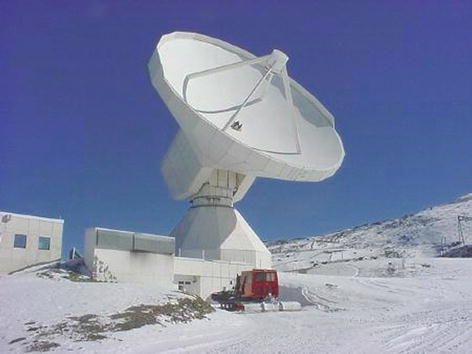
Fig. 1.27
The 30 m telescope on Pico Veleta was
designed for observations in the millimeter range of the spectrum.
This telescope, like all millimeter telescopes, is located on a
mountain to minimize the column density of water in the atmosphere.
Credit: MPIfR, IRAM
The VLA recently underwent a major upgrade, in
particular by installing new receivers. By increasing their
bandwidth relative to the older ones, and installing
state-of-the-art electronics, the sensitivity of the eVLA is about
ten times higher than the ‘old’ VLA. Together with the introduction
of two new frequency bands, the eVLA now covers the full frequency
range from 1 to 50 GHz.
In the radio domain it is also possible to
interconnect completely independent and diverse antennas to form an
interferometer, since one can record the amplitude and phases of
the electromagnetic radiation. For example, in Very Long Baseline
Interferometry (VLBI) radio telescopes on different continents are
used simultaneously. These frequently also include Effelsberg and
the VLA. In 1995 a system of ten identical 25 m antennas was set up
in the USA, exclusively to be used in VLBI, the Very Long Baseline
Array (VLBA). Angular resolutions of better than a milliarcsecond
(mas) can be achieved with VLBI. Therefore, in extragalactic
astronomy VLBI is particularly used in the study of AGNs. With VLBI
we have learned a great deal about the central regions of AGNs,
such as the occurrence of apparent superluminal velocities in these
sources. A further increase in angular resolution with VLBI will be
obtained with the Russian RadioAstron mission, launched in 2011; it
is a 10-m radio telescope on a highly eccentric orbit, reaching
distances from the Earth up to almost 400 000 km.

Fig. 1.28
Left: The James Clerk Maxwell Telescope
(JCMT) on Mauna Kea has a 15 m dish. It is protected by the largest
single piece of Gore-Tex, which has a transmissivity of 97 % at
sub-millimeter wavelengths. Right: The Atacama Pathfinder
Experiment (APEX) 12-m sub-millimeter telescope has been in
operation since 2005. It is located at ∼ 5000 m altitude on the
Chajnantor plateau in the Atacama Desert in Chile, the same
location as that of the ALMA observatory. APEX observes at
wavelengths between 200 μm and 1. 5 mm. Credit: Left: Joint Astronomy Center.
Right:
ESO/H.H. Heyer
Some of the radio telescopes described above are
also capable of observing in the millimeter regime. For shorter
wavelengths the surfaces of the antennas are typically too coarse,
so that special telescopes are needed for wavelengths of 1 mm and
below. The 30 m telescope on Pico Veleta (Fig. 1.27), with its exact
surface shape, allows observations in the millimeter range. It is
particularly used for molecular spectroscopy at these frequencies.
Furthermore, important observations of high-redshift galaxies at
1. 2 mm have been made with this telescope using the bolometer
camera MAMBO (Max-Planck Millimeter Bolometer). Similar
observations are also conducted with the SCUBA (Sub-millimeter
Common-User Bolometer Array) camera at the James Clerk Maxwell
Telescope (JCMT; Fig. 1.28) on Mauna Kea, Hawaii, which observes at
wavelengths between 3 and 0.3 mm. With the SCUBA-camera, operating
at 850 μm (0. 85 mm), we can observe star-formation regions in
distant galaxies for which the optical emission is nearly
completely absorbed by dust in these sources. These dusty
star-forming galaxies can be observed in the (sub-)millimeter
regime of the electromagnetic spectrum even out to large redshifts,
as will be discussed in Sect. 9.3.3. Recently, the SCUBA-2 camera
replaced the original one; its much larger field-of-view
(104 pixels vs. the 37 of SCUBA) enhances its survey
capability by about a factor of 1000.
An even better site for (sub-)mm astronomy than
Mauna Kea is the Cerro Chajnantor, a 5100 m altitude plateau in the
Chilean Atacama desert, due to the smaller column of water vapor.
Since 2005, the Atacama Pathfinder Experiment (APEX) operates
there. It is a 12 m telescope (Fig. 1.28), equipped with
several highly sensitive instruments. One of them is a bolometer
array specifically designed to observe the Sunyaev–Zeldovich effect
in galaxy clusters (see Sect. 6.4.4).

Fig. 1.29
The Atacama Large Millimeter/sub-millimeter
Array (ALMA) on the Chajnantor Plateau, located at an altitude of
5000 m in the Chilean Andes. This photo was taken in December 2012,
4 months prior to the ALMA inauguration. ALMA consists of 50
12-m antennas which can be reconfigurated, to yield different
baselines for interferometry, and an additional compact array of 16
antennas with diameter of 7 and 12 m. Credit: Clem & Adri
Bacri-Normier (wingsforscience.com)/ESO
The site also hosts the ALMA (Atacama Large
Millimeter/sub-millimeter Array) observatory, one of the most
ambitious projects of ground-based astronomy yet (Fig. 1.29). ALMA consists of
50 antennas with 12 m diameter each, which can be moved around to
change the separation between the telescopes (up to 16 km), i.e.,
the baselines for interferometry. In addition, it has a compact
array consisting of twelve 7-m and four 12-m antennas. ALMA will
provide a giant jump in the capabilities of sub-millimeter
astronomy, due to the large collecting area, the large baselines,
as well as the sensitivity and bandwidth of the receivers. The
construction of ALMA, which observes at wavelength longer than
300 μm, was completed in 2013, but even with the incomplete array,
observations were conducted, showing the impressive capabilities of
this new observatory. ALMA is the result of a global cooperation
between North America, Europe and East Asia, together with the host
country Chile.
To measure the tiny temperature fluctuations of
the cosmic microwave background radiation one needs extremely
stable observing conditions and low-noise detectors. In order to
avoid the thermal radiation of the atmosphere as much as possible,
balloons and satellites were constructed to operate instruments at
very high altitude or in space. The American COBE (Cosmic
Background Explorer) satellite measured the anisotropies of the CMB
for the first time, at wavelengths of a few millimeters. In
addition, the frequency spectrum of the CMB was precisely measured
with instruments on COBE. The WMAP (Wilkinson Microwave Anisotropy
Probe) satellite obtained, like COBE, a map of the full sky in the
microwave regime, but at a significantly improved angular
resolution and sensitivity. The first results from WMAP, published
in February 2003, were an enormously important milestone for
cosmology, as will be discussed in Sect. 8.6.5. WMAP observed for a total of
9 years, with a final data release at the end of 2012. The new
European Planck satellite was launched in May 2009, together with
the Herschel satellite. It has a much larger frequency coverage
than WMAP, from 30 to 850 GHz (thus covering both sides of the peak
of the CMB spectrum), a higher sensitivity, and a better angular
resolution. First cosmological results from Planck were released in
March 2013 (see Sect. 8.6.6). Besides observing the CMB
these missions (see Fig. 1.30) are also of great importance for
millimeter astronomy; these satellites not only measure the cosmic
background radiation but of course also the microwave radiation of
the Milky Way and of other galaxies.

Fig. 1.30
Left: Artist’s conception of the Cosmic
Background Explorer (COBE) spacecraft, launched in 1989 into an
Earth orbit, which discovered the temperature fluctuations in the
cosmic microwave background. Middle: The Wilkinson Microwave
Anisotropy Probe (WMAP) satellite was launched in 2001 and observed
the microwave sky for 9 years. Right: The Planck satellite, launched
in 2009 into an orbit at L2 (as for WMAP), has yielded the widest
frequency range and highest angular resolution map of the full
microwave sky yet. Results from these three satellite missions will
be described in Sect. 8.6. Credit: Left: NASA/COBE Science Team.
Middle: NASA/WMAP Science
Team. Right: ESA (Image by
AOES Medialab)

Fig. 1.31
The South Pole Telescope, a 10 m dish
located at 2800 m altitude on the Antarctic Plateau. Its off-axis
design and shielding minimize the effects from ground spill-over
and scattering off the telescope optics. Credit: Glenn Grant,
National Science Foundation
Beside space, the Antarctica offers excellent
observing conditions in the millimeter regime; the very low
temperatures and high altitude (the Antarctic Plateau lies at an
altitude of 2800 m) yields a particularly low column density of
water vapor. Together with the fact that the Sun does not rise and
set every day, the atmospheric conditions are also very stable.
Therefore, several astronomical projects are conducted, or are
being planned, in the Antarctica. One of them is the South Pole
Telescope (SPT, see Fig. 1.31), a 10 m telescope with a one square
degree field-of-view. Its main scientific activity is a survey of
clusters of galaxies through their Sunyaev–Zeldovich effect caused
by the hot intracluster gas, as well as studying the CMB
fluctuations at small angular scales.
1.3.2 Infrared telescopes
In the wavelength range 1 μm ≲ λ ≲ 300 μm, observations from the
Earth’s surface are always subject to very difficult conditions, if
they are possible at all. The atmosphere has some windows in the
near-infrared (NIR, 1 μm ≲ λ ≲ 2. 4 μm) which render ground-based
observations possible. In the mid-infrared (MIR,
2. 4 μm ≲ λ ≲ 20 μm) and
far-infrared (FIR, 20 μm ≲ λ ≲ 300 μm) regimes, observations need
to be carried out from outside the atmosphere, i.e., using
balloons, high-flying airplanes, or satellites. The instruments
have to be cooled to very low temperatures, otherwise their own
thermal radiation would outshine any signal.
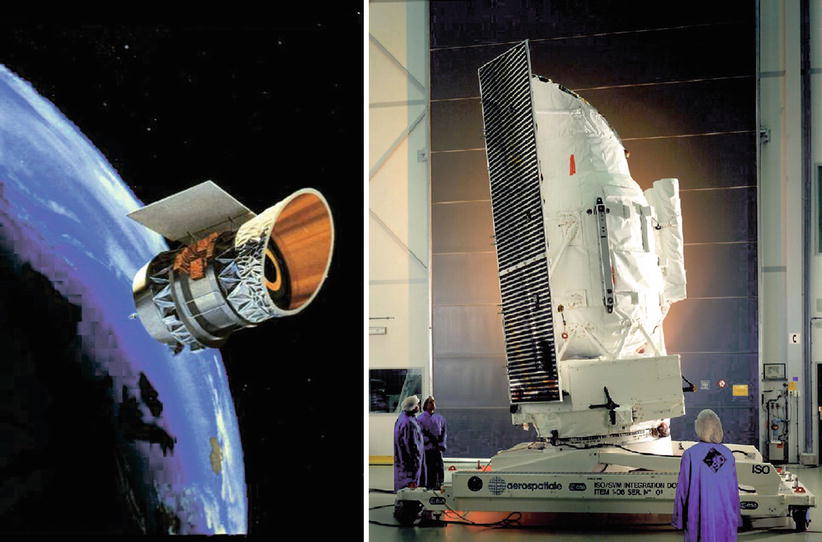
Fig. 1.32
The left-hand picture shows an artist’s
impression of IRAS in orbit. The project was a cooperation of the
Netherlands, the USA, and Great Britain. IRAS was launched in 1983
and operated for 10 months; after that the supply of liquid helium,
needed to cool the detectors, was exhausted. During this time IRAS
scanned 96 % of the sky at four wavelengths. The ISO satellite,
shown on the right, was an
ESA project and observed between 1995 and 1998. Compared to IRAS it
covered a larger wavelength range, had a better angular resolution
and a thousand times higher sensitivity. Credit: NASA’s Infrared
Astrophysics Data Center, Caltech/JPL; ESA
The first noteworthy observations in the
far-infrared were made by the Kuiper Airborne Observatory (KAO), an
airplane equipped with a 91 cm mirror which operated at altitudes
up to 15 km. However, the breakthrough for IR astronomy had to wait
until the launch of IRAS, the InfraRed Astronomical Satellite
(Fig. 1.32).
In 1983, with its 60 cm telescope, IRAS compiled the first IR map
of the sky at 12, 25, 60, and 100 μm, at an angular resolution of
30″ (2′) at 12 μm (100 μm). It discovered about a quarter of a
million point sources as well as about 20 000 extended sources. The
positional accuracy for point sources of better than ∼ 20″ allowed
an identification of these sources at optical wavelengths. Arguably
the most important discovery by IRAS was the identification of
galaxies which emit the major fraction of their energy in the FIR
part of the spectrum. These sources, often called IRAS galaxies,
have a very high star-formation rate where the UV light of the
young stars is absorbed by dust and then re-emitted as thermal
radiation in the FIR. IRAS discovered about 75 000 of these
so-called ultra-luminous IR galaxies (ULIRGs) .
In contrast to the IRAS mission with its prime
task of mapping the full sky, the Infrared Space Observatory ISO
(Fig. 1.32)
was dedicated to observations of selected objects and sky regions
in a wavelength range of 2. 5–240 μm. Although the telescope had
the same diameter as IRAS, its angular resolution at 12 μm was
about a hundred times better than that of IRAS, since the latter
was limited by the size of the detector elements. The sensitivity
of ISO topped that of IRAS by a factor ∼ 1000. ISO carried four
instruments: two cameras and two spectrographs. Among the most
important results from ISO in the extragalactic domain are the
spatially-resolved observations of the dust-enshrouded star
formation regions of ULIRGs.

Fig. 1.33
Left: The Spitzer Space Telescope,
launched in 2003. Right:
The Herschel Space Observatory, launched in 2009 together with the
Planck satellite. Herschel is equipped with a 3.5-m mirror and
three instruments, observing between 60 and 650 μm. Credit:
Left: NASA/JPL-Caltech.
Right: Max-Planck-Institut
für Astronomie/European Space Agency
In 2003 a new infrared satellite was launched
(the Spitzer Space Telescope , see Fig. 1.33) with capabilities
that by far outperform those of ISO. With its 85 cm telescope,
Spitzer observes at wavelengths between 3.6 and 160 μm. Its
Infrared Array Camera (IRAC) takes images at 3.6, 4.5, 5.8 and
8.0 μm simultaneously, and has a field of view of 5.′2
× 5.′2 and 256 × 256 pixels, significantly more than
the 32 × 32 pixels of ISOCAM on ISO that had a comparable
wavelength coverage. The Multiband Imaging Photometer for Spitzer
(MIPS) operated at 24, 70 and 160 μm, and the Infrared Spectrograph
(IRS) was a spectrometer covering the wavelength regime between 5.3
and 40 μm, with a spectral resolution of about  . In 2009,
the helium of the cooler was exhausted, which rendered observations
at longer wavelength impossible. Since then, the Spitzer Warm
Mission continues to observe in the two short wavelengths of IRAC.
Spitzer has made important contributions to all fields of
astronomy, including the first direct detection of light from an
extrasolar planet. Spitzer has provided information about the
thermal dust emission of many nearby and distant galaxies, and thus
of their star-formation activity.
. In 2009,
the helium of the cooler was exhausted, which rendered observations
at longer wavelength impossible. Since then, the Spitzer Warm
Mission continues to observe in the two short wavelengths of IRAC.
Spitzer has made important contributions to all fields of
astronomy, including the first direct detection of light from an
extrasolar planet. Spitzer has provided information about the
thermal dust emission of many nearby and distant galaxies, and thus
of their star-formation activity.
 . In 2009,
the helium of the cooler was exhausted, which rendered observations
at longer wavelength impossible. Since then, the Spitzer Warm
Mission continues to observe in the two short wavelengths of IRAC.
Spitzer has made important contributions to all fields of
astronomy, including the first direct detection of light from an
extrasolar planet. Spitzer has provided information about the
thermal dust emission of many nearby and distant galaxies, and thus
of their star-formation activity.
. In 2009,
the helium of the cooler was exhausted, which rendered observations
at longer wavelength impossible. Since then, the Spitzer Warm
Mission continues to observe in the two short wavelengths of IRAC.
Spitzer has made important contributions to all fields of
astronomy, including the first direct detection of light from an
extrasolar planet. Spitzer has provided information about the
thermal dust emission of many nearby and distant galaxies, and thus
of their star-formation activity.In May 2009, the Herschel Space Observatory
(Fig. 1.33)
was launched, together with the Planck satellite, into an L2
orbit.10 With its
3. 5 m diameter, it was the largest astronomical telescope in space
up to then. In total, the satellite had a diameter of 4 m, a height
of 7.5 m, and weighs 3.4 tons. Herschel covered the spectral range
from far-infrared to sub-millimeter wavelengths (55 μm to 670 μm),
using three instruments: (1) the Photodetector Array Camera and
Spectrometer (PACS), a camera and a low- to medium-resolution
spectrometer for wavelengths up to about 205 μm, (2) the Spectral
and Photometric Imaging REceiver (SPIRE) operated at three bands
longward of λ = 200 μm, and
(3) the Heterodyne Instrument for the Far Infrared (HIFI), a
high-resolution spectrometer operating at λ ≥ 150 μm. The large aperture, the
sensitivity of the instruments and the wide frequency coverage made
Herschel the by far most powerful FIR observatory yet. Herschel
observed until end of April 2013, when it ran out of coolant.
Following the IRAS satellite, two more recent
missions conducted all-sky surveys in the infrared. The Japanese
satellite AKARI, launched in February 2006, mapped the entire sky
at six wavelengths between 9 and 160 μm, and thus produced the
first all-sky survey in the infrared after that of IRAS. The source
catalogs extracted from this survey were publicly released in March
2010 and contain more than 1.3 million sources. The AKARI survey is
about ten times more sensitive than IRAS, and can locate the
position of a point source with an accuracy of better than 2″ at
the shorter wavelengths. Given the scientific impact of the IRAS
survey, one can easily foresee that of the new all-sky results. In
addition, AKARI carried out pointed observations. After its liquid
helium ran out, only observations at shorter wavelengths could be
conducted. The Wide-field Infrared Survey Explorer (WISE) was
launched in December 2009 and mapped the full sky at four wavebands
between 3 and 25 μm, with an angular resolution between 6″ and 12″,
and a more than hundred times larger sensitivity than IRAS. The
resulting catalog from WISE contains positional and photometric
information for over 563 million objects.
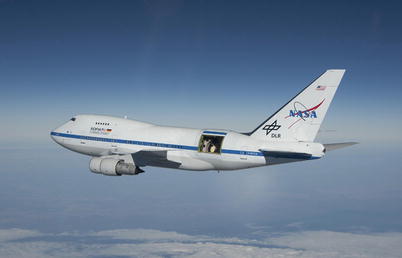
Fig. 1.34
Stratospheric Observatory for Infrared
Astronomy (SOFIA), a 2.5-m telescope onboard a refurbished Boeing
747 aircraft, designed to fly at 12 km altitude. A huge door was
installed which opens at the high cruising altitude to allow for
astronomical observations—a substantial challenge for the
structural stability of the aircraft. Regular observations with
SOFIA started in 2010. Credit: NASA/Jim Ross
Another kind of infrared observatory is the
Stratospheric Observatory for Infrared Astronomy (SOFIA), a 2. 5 m
telescope mounted onboard a refurbished Boeing 747 (see
Fig. 1.34).
Flying at an altitude of 12 km, the observations happen above most
of the Earth atmosphere. SOFIA, a US-German collaboration, has the
advantage that technical developments in instrumentation can be
implemented during the duration of the project.
1.3.3 Optical telescopes
The atmosphere is largely transparent in the
optical part of the electromagnetic spectrum
(0. 3 μm ≲ λ ≲ 1 μm), and
thus we are able to conduct observations from the ground. Since for
the atmospheric windows in the NIR one normally uses the same
telescopes as for optical astronomy, we will not distinguish
between these two ranges here. Despite the tremendous progress made
in all wavelength regimes, the optical and NIR spectral region is
arguably the single most informative for astronomy, for a
combination of two reasons: first, most of the radiation emitted by
galaxies is light from stars which has its maximum in the optical
regime or, in case of star formation obscured by dust, in the FIR
regime, and second, the efficiency of optical detectors is highest,
much more than those of infrared detectors. Together, these two
points cause the observable number density of sources on the sky to
be highest for optical observations.

Fig. 1.35
Telescopes at the summit of Mauna Kea,
Hawaii, at an altitude of 4200 m. The cylindrical dome to the left
and below the center of the image contains the Subaru 8-m
telescope; just behind it are the two 10-m Keck telescopes. The two
large domes at the back house the Canada-France-Hawaii telescope
(CFHT, 3.6 m) and the 8-m Gemini North. The telescope at the
lower right is the 15-m James Clerk Maxwell sub-millimeter
telescope (JCMT). Credit: R. Wainscoat, University of
Hawaii
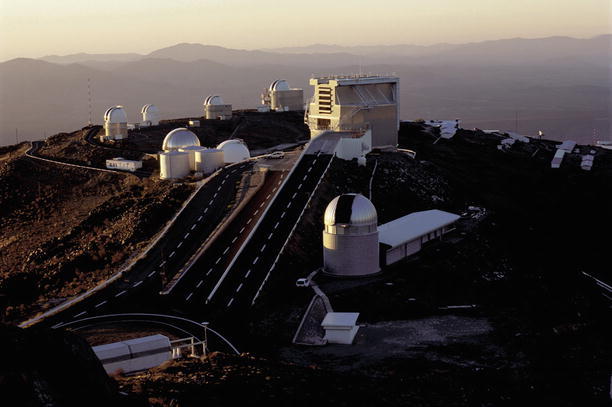
Fig. 1.36
The La Silla Observatory of ESO in Chile.
On the peak in the middle, one can see the New Technology Telescope
(NTT), a 3.5-m prototype of the VLT. The silvery shining dome to
its left is the MPG/ESO 2.2-m telescope whose Wide Field Imager, a
80962 pixel camera with a 0.5∘ field-of-view,
has been a very competitive instrument in the past decade. The
picture was taken from the location of the 3.6-m telescope, the
largest one on La Silla. Credit: European Southern
Observatory
Although optical astronomy has been pursued for
many decades, it has evolved very rapidly in recent years. This is
linked to a large number of technical achievements. A good
illustration of this is the 10-m Keck telescope which was put into
operation in 1993; this was the first optical telescope with a
mirror diameter of more than 6 m. Constructing telescopes of this
size became possible by the development of active optics, a method
to control the surface of the mirror. A mirror of this size no
longer has a stable shape but is affected, e.g., by gravitational
deformation as the telescope is steered. Such a large mirror, in
order to have a stable shape, would need to have a thickness
comparable with its diameter, and producing and operating such
mirrors is infeasible. It was also realized that part of the air
turbulence that generates the seeing is caused by the telescope and
its dome itself. By improving the thermal condition of telescopes
and dome structures a reduction of the seeing could be achieved.
The aforementioned replacement of photographic plates by CCDs,
together with improvements to the latter, resulted in a vastly
enhanced quantum efficiency of ∼ 70 % (at maximum even more than 90 %),
barely leaving room for further improvements.
The throughput of optical telescopes has been
immensely increased by designing wide-field CCD cameras, the
largest of which is currently that of PanSTARRS, with ∼ 1. 4 ×
109 pixels, covering ∼ 7 deg2. Furthermore,
multi-object spectrographs have been built which allow us to
observe the spectra of a large number of objects simultaneously.
The largest of them are able to get spectra for several hundred
sources in one exposure. Finally, with the Hubble Space Telescope
the angular resolution of optical observations was increased by a
factor of ∼ 10 compared to the best sites on Earth. Further
developments that will revolutionize the field even more, such as
interferometry in the near IR/optical and adaptive optics, have
recently been added to these achievements.
Currently, 13 optical telescopes of the 4-m class
exist worldwide. They differ mainly in their location and their
instrumentation. For example, the Canada-France-Hawaii Telescope
(CFHT) on Mauna Kea (Fig. 1.35) has been a leader in wide-field
photometry for many years, due to its extraordinarily good seeing.
This is again emphasized by the installation of Megacam, a one
square degree camera with 18 000 × 18 000 pixels. The
Anglo-Australian Telescope (AAT) in Australia, in contrast, has
distinctly worse seeing and has therefore specialized, among other
things, in multi-object spectroscopy, for which the 2dF (two degree
field) instrument was constructed. Most of these telescopes are
also equipped with NIR instruments. The New Technology Telescope
(NTT, see Fig. 1.36) made its largest contributions with its
SOFI camera, a near-IR instrument with a large field-of-view
of ∼ 5′ × 5′ and an excellent image quality.
Hubble Space
Telescope. To avoid the greatest problem in ground-based
optical astronomy, the rocket scientist Hermann Oberth speculated
already in the 1920s about telescopes in space which would not be
affected by the influence of the Earth’s atmosphere. In 1946 the
astronomer Lyman Spitzer took up this issue again and discussed the
possibilities for the realization of such a project.
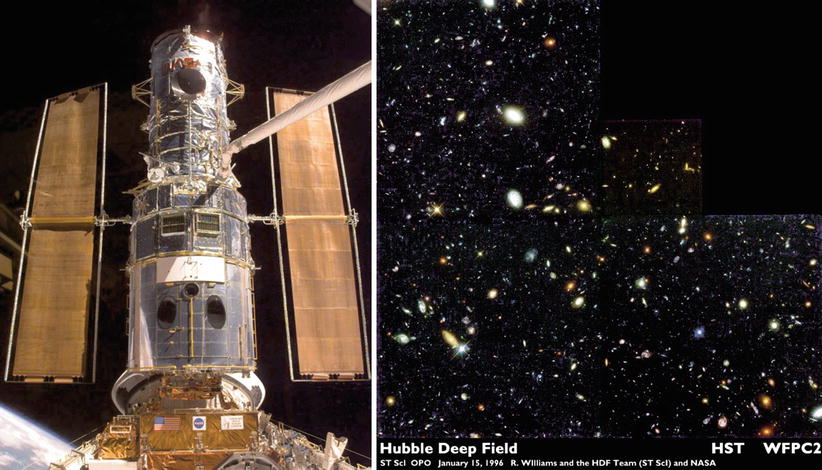
Fig. 1.37
Left: The HST mounted on the
manipulator arm of the Space Shuttle during one of the servicing
missions. Right: The Hubble
Deep Field (North) was observed in December 1995 and the data
released 1 month later. To compile this multicolor image, which at
that time was the deepest image of the sky, images from four
different filters were combined. The geometry of the field is due
to the arrangement of the CCD detector arrays in the Wide Field and
Planetary Camera 2, where one of the four chips is smaller than the
other three and due to a smaller pixel scale. Credit: STScI,
NASA
Shortly after NASA was founded in 1958, the
construction of a large telescope in space was declared a long-term
goal. After several feasibility studies and ESA’s agreement to join
the project, the HST was finally built. However, the launch was
delayed by the explosion of the space shuttle ‘Challenger’ in 1986,
so that it did not take place until April 24, 1990. An unpleasant
surprise came as soon as the first images were taken: it was found
that the 2.4 m main mirror was ground into the wrong shape. This
problem was remedied in December 1993 during the first “servicing
mission” (a series of Space Shuttle missions to the HST;
see Fig. 1.37), when a correction lens was installed.
After this, the HST could observe at its diffraction limit, i.e.,
with an angular resolution of better than 0.″1, and
became one of the most successful and best-known scientific
instruments. In fact, the HST was far more important for
extragalactic astronomy than anticipated before its launch, due to
the fact that distant galaxies turned out to be much more compact
than their local counterparts, and thus have a higher surface
brightness. A main contributor to the success (and cost) of HST was
a series of five visits to the telescope, where not only parts that
failed (e.g., gyroscopes) were replaced and thus the lifetime of
the observatory extended to well over 20 years, but also new,
increasingly more powerful instruments were installed.
After the final servicing mission SM-4 in 2009,
the HST carries a powerful suite of scientific instruments. The ACS
(Advanced Camera for Surveys) has a field-of-view of
3.′4 × 3.′4 and a pixel scale of
0.″05. It was installed on Hubble in 2002, had to be
shut down after a malfunction in 2007, but after the repair in
2009, it continues to be a powerful workhorse for high-resolution
imaging in the optical wavebands. Several imaging surveys have been
carried out with ACS, some of which will be considered in some
detail in later chapters. Newly installed during SM-4 was the Wide
Field Camera 3 (WFC3) , replacing the WFPC2 (Wide Field and
Planetary Camera), which has been the most active instrument of HST
since then. WFC3 covers a very broad range of wavebands,
distributed over two different ‘channels’. The UVIS channel
operates between 0. 2 and 1 μm with a 2.′6 field of
view, whereas the NIR channel operates between 0. 85 and 1. 7 μm
and has a ∼ 2′ field. This field is considerably larger than that
of the other NIR instrument on HST, the NICMOS (Near Infrared
Camera and Multi Object Spectrograph) instrument. Already in its
first months of operation, WFC3 led to great progress in the field
of very high redshift galaxies, by increasing the number of known
galaxies with redshifts z ≥ 6 by a large factor. The SM-4
mission also brought the Cosmic Origins Spectrograph (COS) to HST,
operating in the UV region of the spectrum. The spectroscopic
capability of HST in the UV-range, unavailable from the ground, was
increased with COS by a large factor compared to the other UV
instrument STIS (Space Telescope Imaging Spectrograph).
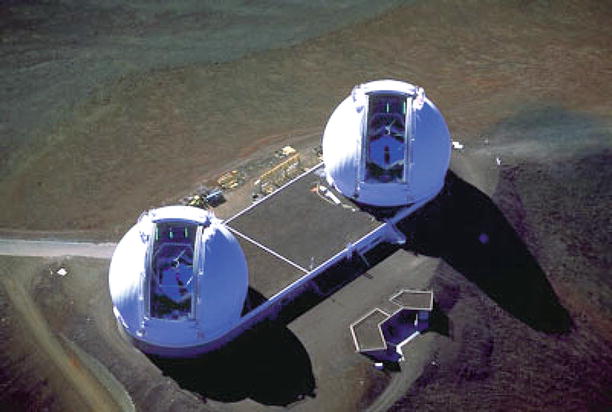
Fig. 1.38
The two Keck telescopes on Mauna Kea. With
Keck I the era of large telescopes was heralded in 1993.
Credit: R. Wainscoat, University of Hawaii
HST has provided important insights into our
Solar System and the formation of stars, but it has achieved
milestones in extragalactic astronomy. With HST observations of the
nucleus of M87 (Fig. 1.11), one derived from the Doppler shift of
the gas emission that the center of this galaxy contains a black
hole of 2 billion Solar masses. HST has also proven that black
holes exist in other galaxies and AGNs. The enormously improved
angular resolution has allowed us to study galaxies to a hitherto
unknown level of detail.
Arguably the most important contribution of the
HST to extragalactic astronomy are the Hubble Deep Fields.
Scientists managed to convince Robert Williams, then director of
the Space Telescope Science Institute, to use the HST to take a
very deep image in an empty region of the sky, a field with
(nearly) no foreground stars and without any known clusters of
galaxies. At that time it was not clear whether anything
interesting at all would result from these observations. Using the
observing time that is allocated to the Director, the ‘director
discretionary time’, HST was pointed at such a field in the Big
Dipper, taking data for 10 days December 1995. The outcome was the
Hubble Deep Field North (HDFN), one of the most important
astronomical data sets, displayed in Fig. 1.37. From the HDFN and
its southern counterpart, the HDFS, one obtains information about
the early states of galaxies and their evolution. One of the first
conclusions was that most of the early galaxies are very small and
classified as irregulars. In 2002, the Hubble Ultra Deep Field
(HUDF) was observed with the then newly installed ACS camera. Not
only did it cover about twice the area of the HDFN but it was even
deeper, by about one magnitude, owing to the higher sensitivity of
ACS compared to WFPC2. We will discuss some of the imaging surveys
of HST in more detail in Sect. 9.2.1.
Large
Telescopes. For more than 40 years the 5-m telescope on Mt.
Palomar was the largest telescope in the western world—the Russian
6-m telescope suffered from major problems from the outset. 1993
saw the birth of a new class of telescopes, of which the two Keck
telescopes (see Fig. 1.38) were the first, each with a mirror
diameter of 10 m.11
The site of the two Kecks at the summit of Mauna
Kea (see Fig. 1.35) provides ideal observing conditions for
many nights per year. This summit is now home to several large
telescopes. The Japanese Subaru telescope and Gemini North are also
located here, as well as the aforementioned CFHT and JCMT. The
significant increase in sensitivity obtained by Keck, especially in
spectroscopy, permitted completely new insights, for instance
through absorption line spectroscopy of quasars. Keck was also
essential for the spectroscopic verification of innumerable
galaxies of redshift z ≳ 3,
which are normally so dim that they cannot be examined with smaller
telescopes.

Fig. 1.39
The Paranal observatory after completion.
The four large domes host one of the VLTs each. The smaller dome,
seen to the left of the rightmost VLT, hosts the VLT Survey
Telescope (VST), a dedicated 2.6 m telescope equipped with the
wide-field optical camera OmegaCAM. The four much smaller domes
host 1.5 m auxiliary telescopes, which are used in combination with
the VLTs for optical interferometry. In the background, the VISTA
(Visible and Infrared Survey Telescope for Astronomy) telescope is
seen, equipped with a wide-field near-infrared camera. The
buildings in front contain the control room for the telescopes and
instruments, and a guest house for observers. Before the
observatory was constructed, the top of the mountain was flattened
to get a leveled surface of diameter ∼ 300 m, large enough to
accommodate the telescopes and the facilities used for optical
interferometry (VLTI). Credit: European Southern
Observatory/G.Hüdepohl
The largest ground-based telescope project to
date was the construction of the Very Large Telescope (VLT) of the
European Southern Observatory (ESO), consisting of four telescopes
each with a diameter of 8.2 m. ESO already operated the La Silla
Observatory in Chile (see Fig. 1.36), but a better location was found for the
VLT, the Cerro Paranal (at an altitude of 2600 m). This mountain is
located in the Atacama desert, one of the driest regions on Earth.
To build the telescopes on the mountain a substantial part of the
mountain top first had to be cut off (Fig. 1.39).
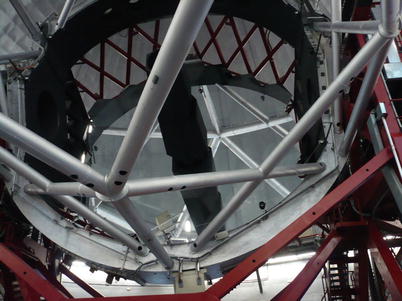
Fig. 1.40
The segmented mirror of the Gran Telescopio
Canarias (GTC) at the Roque de los Muchachos Observatory on La
Palma, inside its support structure. The hexagonal elements can
clearly be seen. At an altitude of 2400 m, this observatory is the
best astronomical site in Europe. Credit: P. Schneider,
Argelander-Institut für Astronomie, Universität Bonn
In contrast to the Keck telescopes and the Gran
Telescopio Canarias (GTC; see Fig. 1.40), which have a
primary mirror that is segmented into 36 hexagonal elements, the
mirrors of the VLT are monolithic, i.e., they consist of a single
piece. However, they are very thin compared to the 5-m mirror on
Mt. Palomar, far too thin to be intrinsically stable against
gravity and other effects such as thermal deformations. Therefore,
as for the Kecks, the shape of the mirrors has to be controlled
electronically (see Fig. 1.41). The monolithic structure of the VLT
mirrors yields a better image quality than that of the Keck
telescopes, resulting in an appreciably simpler point-spread
function.12
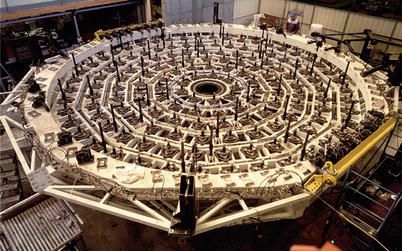
Fig. 1.41
The active optics system at the VLT. Each
mirror is supported at 150 points; at these points, the mirror is
adjusted to correct for deformations. The primary mirror is always
shaped such that the light is focused in an optimal way, with its
form being corrected for the changing gravitational forces when the
telescope changes the pointing direction. In adaptive optics, in
contrast to active optics, the wave front is controlled: the
mirrors are deformed with high frequencies in such a way that the
wave front is as planar as possible after passing through the
optical system. In this way one can correct for the permanently
changing atmospheric conditions and achieve images at
diffraction-limited resolution, though only across a fairly small
region of the focal plane. Credit: European Southern
Observatory
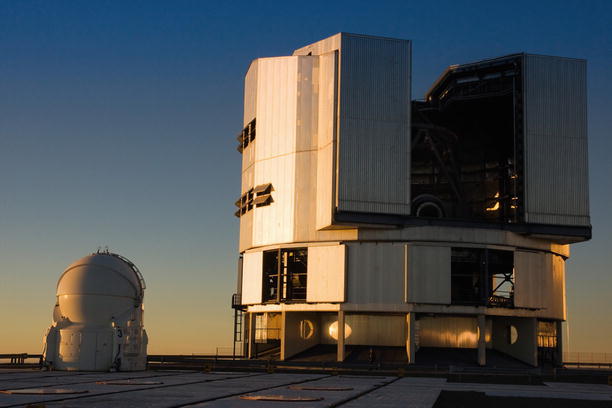
Fig. 1.42
One of the four Unit Telescopes of the VLT
on the right, together with one of the auxiliary telescopes at the
left. These auxiliary telescopes can be moved to allow for variable
baseline configurations in optical interferometry. Credit: Iztok
Boncina/European Southern Observatory
Each of the four telescopes has three accessible
foci; this way, 12 different instruments can be installed at the
VLT at any time. Switching between the three instruments is done
with a deflection mirror. The permanent installation of the
instruments allows their stable operation.
The VLT (Fig. 1.42) also marked the beginning of a new form
of ground-based observation with large optical telescopes. Whereas
until recently an astronomer proposing an observation was assigned
a certain number and dates of nights in which she could observe
with the telescope, the VLT is mainly operated in the so-called
service mode. The observations are performed by local astronomers
according to detailed specifications that must be provided by the
principal investigator of the observing program, and the data are
then transmitted to the astronomer at her home institution.
A significant advantage of this procedure is that one can
better account for special requirements for observing conditions.
For example, observations that require very good seeing can be
carried out during the appropriate atmospheric conditions. With
service observing the chances of getting a useful data set are
increased. More than half of the observations with the VLT are
performed in service mode.
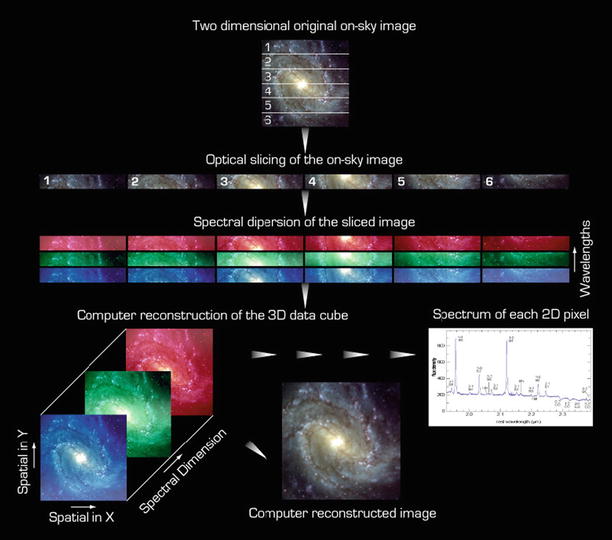
Fig. 1.43
The principle of an integral field unit
(IFU) based on image slicing is illustrated. In a first step, the
image of an object is ‘sliced’, using an arrangement of mirrors.
The light of each slice is then send through a long-slit
spectrograph, so that a spectrum from each pixel of a slice is
obtained. Hence, in this way one obtains a spectrum of each pixel
element in the area of the extended object. Adding up the light
from all wavelengths in a pixel then yields the original image of
the object. By weighting the contributions from the various
wavelengths by an appropriate filter function, images in different
wavebands can be obtained. Using lines in the spectrum of each
image element, the corresponding Doppler shift can be obtained and
a two-dimensional velocity field of the object (such as a rotation
curve) can be reconstructed. Credit: European Southern
Observatory
Another aspect of service observing is that the
astronomer does not have to make the long journey, at the expense
of also missing out on the adventure and experience of observing.
As mentioned before, the best astronomical sites are at quite
remote places, and traveling to such an observatory is a physical
experience. A trip from, e.g., Bonn to the Paranal starts with a
train ride to Düsseldorf airport, a flight from there to Paris or
Madrid, followed by a more than 12 h flight to Santiago de Chile.
From there, another 2 h flight towards the Northern coast of Chile
takes one to the city of Antofagasta. The final part of the journey
is a 2 h car ride through the desert—literally, the last plant one
sees in the outskirts of Antofagasta. And finally, from the
distance, one can see the four majestic domes on the top of a
mountain, the final destination of the journey.
Adaptive optics,
integral field spectroscopy, and interferometry. New
technical innovations in astronomy lead to improved data products;
two examples should be mentioned here. One is adaptive optics, a
technique to obtain an angular resolution approaching the
diffraction limit of the telescope. This is usually not the case,
as turbulence in the atmosphere leads to a blurring of an image. In
adaptive optics, one accounts for this by deforming the mirror at a
high frequency, as to counteract the changing image position on the
sky due to the turbulence. The wavefront of the incoming light is
controlled by observing a bright reference source located closely
on the sky to the target of interest. The motion of the reference
source on the CCD then yields the necessary information about the
wavefront deformation, which thus can be corrected for. In many
cases, the source to be observed does not have a bright source
close-by. One way to use adaptive optics in this situation is to
generate an artificial source on the sky, by pointing a laser
upwards. By tuning the laser to a wavelength of 5892 Å, sodium
atoms in the upper atmosphere at ∼ 90 km altitude are excited and
re-emit the light. In this way, an artificial light source (called
laser guide star) is created which is viewed through the same
atmosphere as the source of interest.
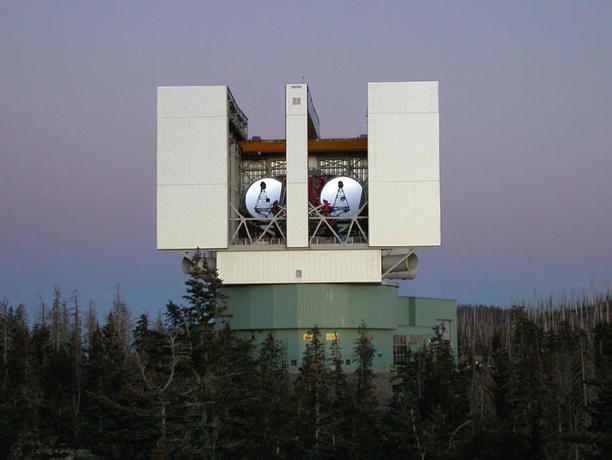
Fig. 1.44
The Large Binocular Telescope (LBT) on
Mount Graham in Arizona. The two 8.4 m primary mirrors are mounted
on a single structure, share one gigantic dome, and has been built
specifically for optical interferometry. Credit: Large Binocular
Telescope Observatory; courtesy NASA/JPL-Caltech
Another innovative technique, called integral
field spectroscopy , allows one to obtain the spectral energy
distribution for different regions of an extended source, pixel by
pixel. Several different methods for this are used; a particular
one, based on image slicing by an arrangement of mirrors, is
explained in more detail in Fig. 1.43.
Optical interferometry is also reaching a state
of maturity. Like in radio astronomy, the light received from
several telescopes can be combined to obtain a higher-resolution
image of a source. In contrast to VLBI techniques, the light at the
different telescopes is not recorded and correlated afterwards;
instead, the light beams from the different telescopes need to be
combined directly. Below the plateau of the Paranal observatory is
a large tunnel system where the light beams of the VLTs and/or the
auxiliary telescopes are combined. The two Keck telescopes were
built on a common structure to enable interferometry. The latest
development in optical interferometry is the Large Binocular
Telescope (LBT) , where the two mirrors are mounted on a single
structure (see Fig. 1.44).
1.3.4 UV telescopes
Radiation with a wavelength shorter than
λ ≲ 0. 3 μm = 3000 Å cannot
penetrate the Earth’s atmosphere but is instead absorbed by the
ozone layer, whereas radiation at wavelengths below 912 Å is
absorbed by neutral hydrogen in the interstellar medium. The range
between these two wave-lengths is the UV part of the spectrum, in
which observation is only possible from space.
The Copernicus satellite (also known as the
Orbiting Astronomical Observatory 3, OAO-3) was the first long-term
orbital mission designed to observe high-resolution spectra at
ultraviolet wavelengths. In addition, the satellite contained an
X-ray detector. Launched on August 21, 1972, it obtained UV spectra
of 551 sources until its decommissioning in 1981. Among the
achievements of the Copernicus mission are the first detection of
interstellar molecular hydrogen H2 and of CO, and
measurements of the composition of the interstellar medium as well
as of the distribution of Ovi, i.e., five-time ionized
oxygen.
The IUE (International Ultraviolet Explorer)
operated between 1978 and 1996 and proved to be a remarkably
productive observatory. During its 18 years of operation more than
105 spectra of galactic and extragalactic sources were
obtained. In particular, the IUE contributed substantially to our
knowledge of AGN.
The HST, with its much larger aperture, marks the
next substantial step in UV astronomy. Many new insights were
gained with the HST, especially through spectroscopy of quasars in
the UV, insights into both the quasars themselves and, through the
absorption lines in their spectra, into the intergalactic medium
along the line-of-sight towards the sources. In 1999 the FUSE (Far
Ultraviolet Spectroscopic Explorer) satellite was launched. From UV
spectroscopy of absorption lines in luminous quasars this satellite
provided us with a plethora of information on the state and
chemical composition of the intergalactic medium.
While the majority of observations with UV
satellites were dedicated to high-resolution spectroscopy of stars
and AGNs, the prime purpose of the Galaxy Evolution Explorer
(GALEX) satellite mission (Fig. 1.45), launched in 2003, was to compile
extended photometric surveys. GALEX observed at wavelengths
1350 Å ≲ λ ≲ 2830 Å and
performed a variety of surveys. Amongst them are the All-Sky
Imaging Survey, covering 26 000 square degrees of the extragalactic
sky, the Medium Imaging survey, with considerably deeper imaging of
1000 square degrees in field where spectroscopic redshift surveys
(like SDSS) were available, and the Deep Imaging Survey of 80
square degrees and an exposure time of about 8 h per field. Several
more specialized surveys were carried out, including one on nearby
galaxies and on the Milky Way. In addition, GALEX performed several
spectroscopic surveys. The results from GALEX are of great
importance, especially for the study of the star-formation rate in
nearby and distant galaxies. In June 2013, the operation of GALEX
was terminated.
1.3.5 X-ray telescopes
As mentioned before, interstellar gas absorbs
radiation at wavelengths shortward of 912 Å, the so-called Lyman
edge. This corresponds to the ionization energy of hydrogen in its
ground state, which is 13. 6 eV. Only at energies about ten times
this value does the ISM become transparent again13 and this denotes the low-energy
limit of the domain of X-ray astronomy. Typically, X-ray
astronomers do not measure the frequency of light in Hertz (or the
wavelength in μm), but instead photons are characterized by their
energy, measured in electron volts (eV).
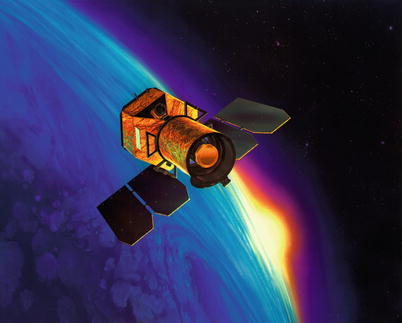
Fig. 1.45
The Galaxy Evolution Explorer GALEX was
launched in 2003, and decommissioned after 10 years of astronomical
observations in June 2013. GALEX had a 50 cm mirror and operated in
the UV spectral range. Credit: NASA/JPL-Caltech
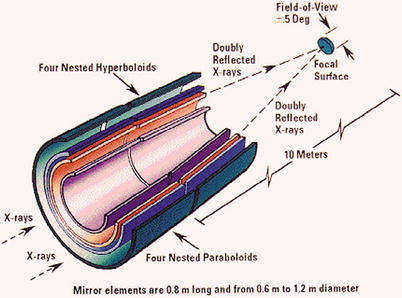
Fig. 1.46
Principle of a Wolter telescope for X-ray
astronomy. X-rays are reflected by a metal surface only if the
angle of incidence is very small, i.e., if the photon direction is
almost parallel (within ∼ 2∘) to the metal surface. This
principle can be employed for X-ray mirrors, by constructing a
tube, consisting of a paraboloidal shaped surface combined with a
hyperboloidal one in a way that X-ray photons are focussed. The
effective area of such a mirror is very small, as only a small
annular region of the photon beam hits this mirror, due to the
small projected surface. The X-ray telescopes on XMM and Chandra
are therefore composed of nested layers of such surfaces, each one
acting like a focusing surface by itself, thereby multiplying the
effective area. The figure illustrates the mirror of the Chandra
observatory. Source: Wikipedia
The birth of X-ray astronomy was in the 1960s.
Rocket and balloon-mounted telescopes which were originally only
supposed to observe the Sun in X-rays also received signals from
outside the Solar System. UHURU (the Swahili word for ‘freedom’)
was the first satellite to observe exclusively the cosmic X-ray
radiation and compiled the first X-ray map of the sky, discovering
about 340 sources. This catalog of point sources was expanded in
several follow-up missions, especially by NASA’s High Energy
Astrophysical Observatory (HEAO-1) which also detected a diffuse
X-ray background radiation. On HEAO-2, also known as the Einstein
satellite, the first Wolter telescope (see Fig. 1.46) was used for
imaging, increasing the sensitivity by a factor of nearly a
thousand compared to earlier missions. The Einstein observatory
also marked a revolution in X-ray astronomy because of its high
angular resolution, about 2″ in the range of 0.1–4 keV. Among the
great discoveries of the Einstein satellite is the X-ray emission
of many clusters of galaxies that traces the presence of hot gas in
the space between the cluster galaxies. The total mass of this gas
significantly exceeds the mass of the stars in the cluster galaxies
and therefore represents the main contribution to the baryonic
content of clusters.

Fig. 1.47
Left: ROSAT, a German-US-British
cooperation, observed from 1990 to 1999 in the energy range between
0.1 and 2.5 keV (soft X-ray). Upper right: Chandra was launched in
July 1999. The energy range of its instruments lies between 0.1 and
10 keV. Its highly elliptical orbit permits long uninterrupted
exposures. Lower right:
XMM-Newton was launched in December 1999 and has since been in
operation; it is the most successful ESA mission up to today, as
measured from the number of publications resulting from its data.
Observations are carried out with three telescopes at energies
between 0.1 and 15 keV. Credit: Left: Max-Planck-Intitut für
extraterrestrische Forschung (MPE) & DLR. Top right: NASA/CXC/SAO. Bottom right: European Space
Agency
The next major step in X-ray astronomy was ROSAT
(ROentgen SATellite; Fig. 1.47), launched in 1990. During the first 6
months of its 9-year mission ROSAT produced an all-sky map at far
higher resolution than UHURU; this is called the ROSAT All Sky
Survey. More than 105 individual sources were detected
in this survey, the majority of them being AGNs. In the subsequent
period of pointed observations ROSAT examined, among other types of
sources, clusters of galaxies and AGNs. One of its instruments (the
Position Sensitive Proportional Counter PSPC) provided spectral
information in the range between 0.1 and 2.4 keV at an angular
resolution of ∼ 20″, while the other (High-Resolution Instrument
HRI) instrument had a much better angular resolution ( ∼ 3″) but
did not provide any spectral information. The Japanese X-ray
satellite ASCA (Advanced Satellite for Cosmology and Astrophysics),
launched in 1993, was able to observe in a significantly higher
energy range of 0.5–12 keV and provided spectra of higher energy
resolution, though at reduced angular resolution.
Since 1999 two new powerful satellites are in
operation: NASA’s Chandra observatory and ESA’s XMM-Newton (X-ray
Multi-Mirror Mission; see Fig. 1.47). Both have a large photon-collecting area
and a high angular resolution, and they also set new standards in
X-ray spectroscopy. Compared to ROSAT, the energy range accessible
with these two satellites is larger, from 0.1 to ∼ 10 keV. The
angular resolution of Chandra is about 0.″5 and thus,
for the first time, comparable to that of optical telescopes. This
high angular resolution led to major discoveries in the early years
of operation. For instance, well-defined sharp structures in the
X-ray emission from gas in clusters of galaxies were discovered, as
well as X-ray radiation from the jets of AGNs which had been
previously observed in the radio. Furthermore, Chandra discovered a
class of X-ray sources, termed Ultra-luminous Compact X-ray Sources
(ULXs), in which we may be observing the formation of black holes
(Sect. 9.3.1). XMM-Newton has a larger
sensitivity compared to Chandra, however at a somewhat smaller
angular resolution. Among the most important observations of
XMM-Newton are the spectroscopy of AGNs and of clusters of
galaxies.

Fig. 1.48
The left
image shows the Compton Gamma Ray Observatory (CGRO) mounted
on the Space Shuttle manipulator arm. This NASA satellite carried
out observations between 1991 and 2000. It was finally shut down
after a gyroscope failed, and it burned up in the Earth’s
atmosphere in a controlled re-entry. ESA’s Integral observatory, in
operation since 2002, is shown on
the right. Credit: Left: NASA. Right: ESA
With Suzaku , a Japanese satellite launched in
July 2005, a new X-ray observatory became available. One of its
advantages compared to Chandra and XMM-Newton is its low orbit
around the Earth, which keeps it inside the Earth magnetosphere and
thus shields it from most of the Solar wind. Therefore, the
radiation background of Suzaku is lower than for the other two
X-ray observatories. This renders Suzaku particularly useful to
study the low surface brightness outer regions of galaxy
clusters.
1.3.6 Gamma-ray telescopes
The existence of gamma radiation was first
postulated in the 1950s. This radiation is absorbed by the
atmosphere, which is fortunate for the lifeforms on Earth. The
first γ-ray telescopes were
mounted on balloons, rockets, and satellites, and picked up fewer
than 100 photons from cosmic sources. Those gamma photons had
energies in the GeV range and above.
Detailed observations became possible with the
satellites SAS-2 and COS-B. They compiled a map of the galaxy,
confirmed the existence of a gamma background radiation, and for
the first time observed pulsars in the gamma range. The first Gamma
Ray Bursts (GRB), extremely bright and short-duration flashes on
the gamma-ray sky, were detected from 1967 onwards by military
satellites. Only the Italian-Dutch satellite Beppo-SAX (1996–2002)
managed to localize a GRB with sufficient accuracy to allow an
identification of the source in other wavebands, and thus to reveal
its physical nature; we will come back to this subject in
Sect. 9.7.
An enormous advance in high-energy astronomy was
made with the launch of the Compton Gamma Ray Observatory (CGRO;
Fig. 1.48) in
1991; the observatory was operational for 9 years. It carried four
different instruments, among them the Burst And Transient Source
Experiment (BATSE) and the Energetic Gamma Ray Experiment Telescope
(EGRET). During its lifetime BATSE discovered about 3000 GRBs and
contributed substantially to the understanding of the nature of
these mysterious gamma-ray flashes. EGRET discovered many AGNs at
very high energies above 20 MeV, which hints at extreme processes
taking place in these objects.
One of the successors of the CGRO, the Integral
satellite, was put into orbit as an ESA mission by a Russian Proton
rocket at the end of 2002. At a weight of two tons, it was the
heaviest ESA satellite that had been launched by then. It observes
primarily at energies between 15 keV and 10 MeV in the gamma range,
but has additional instruments for observation in the optical and
X-ray regimes.
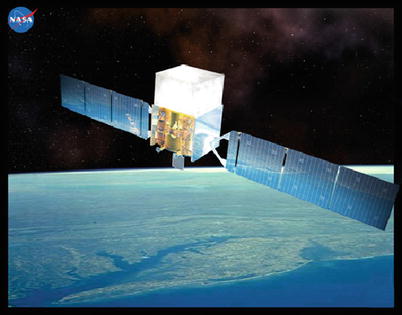
Fig. 1.49
Artist’s drawing of the Fermi satellite,
launched in 2008. Fermi observes at energies between 10 keV and
300 GeV. Credit: NASA E/PO, Sonoma State University, Aurore
Simonnet
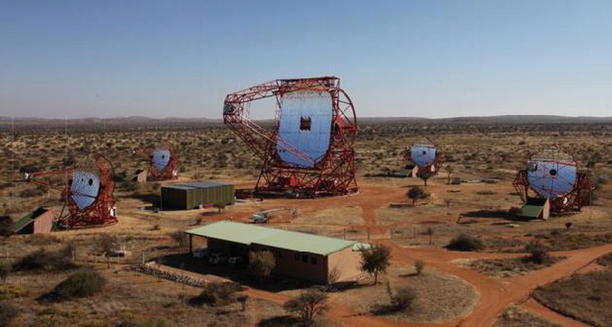
Fig. 1.50
The four 13 m-diameter telescopes, and the
new 28-m telescope of the High Energy Stereoscopic System
(H.E.S.S.) in Namibia, in South-West Africa. The optical quality of
these mirrors is much lower than that of other optical telescopes.
The angular resolution of the telescopes needs not to be better
than a few arcminutes, as given by the width of the cone into which
the Cherenkov light is emitted. Correspondingly, the pixel size is
also adapted to this required angular resolution. Credit:
H.E.S.S.-collaboration/Max-Planck-Institut für Kernphysik,
Heidelberg
The other successor of the CGRO was launched in
June 2008, the Fermi Gamma-ray Space telescope (Fig. 1.49). It carries two
main instruments, the gamma-ray burst monitor (GBM) and the Large
Area Telescope (LAT). With an energy range between 30 MeV and
300 GeV, comparable to, but wider than that of EGRET on CGRO, the
LAT observes in a higher energy regime than Integral. Compared to
EGRET, Fermi-LAT has higher sensitivity, a fourfold field-of-view
(corresponding to 1/6 of the full sky), a better angular and energy
resolution and a much better time resolution. Observations are
conducted in the sky survey mode, mapping the whole sky every 3 h.
Fermi-LAT made significant discoveries in its first years of
operations in the field of pulsar, gamma-ray bursts, active
galactic nuclei and the gamma-ray background radiation.
At energies above 100 GeV, the photon flux even
from the brightest sources is too small to be detectable with
space-based instruments—characteristic values are  above 1 TeV, or a few photons per m2 per year. However,
photons of these energies can be detected from the ground, using
methods derived from cosmic ray physics. They make use of the fact
that a high-energy photon hits an atom in the upper atmosphere, and
in the interaction process, additional particles are generated,
which by themselves are energetic enough to produce charged
particles in further collisions. In this way, a number of particles
are produced that are ultra-relativistic (meaning that their
velocity is very close to that of the velocity of light) and all
propagate in essentially the same direction as the incoming photon.
Such a process is called an air shower. There are two different
ways these air showers can be detected. First, some particles from
the air shower propagate to the ground, and can there be detected
in particle detectors.
above 1 TeV, or a few photons per m2 per year. However,
photons of these energies can be detected from the ground, using
methods derived from cosmic ray physics. They make use of the fact
that a high-energy photon hits an atom in the upper atmosphere, and
in the interaction process, additional particles are generated,
which by themselves are energetic enough to produce charged
particles in further collisions. In this way, a number of particles
are produced that are ultra-relativistic (meaning that their
velocity is very close to that of the velocity of light) and all
propagate in essentially the same direction as the incoming photon.
Such a process is called an air shower. There are two different
ways these air showers can be detected. First, some particles from
the air shower propagate to the ground, and can there be detected
in particle detectors.
 above 1 TeV, or a few photons per m2 per year. However,
photons of these energies can be detected from the ground, using
methods derived from cosmic ray physics. They make use of the fact
that a high-energy photon hits an atom in the upper atmosphere, and
in the interaction process, additional particles are generated,
which by themselves are energetic enough to produce charged
particles in further collisions. In this way, a number of particles
are produced that are ultra-relativistic (meaning that their
velocity is very close to that of the velocity of light) and all
propagate in essentially the same direction as the incoming photon.
Such a process is called an air shower. There are two different
ways these air showers can be detected. First, some particles from
the air shower propagate to the ground, and can there be detected
in particle detectors.
above 1 TeV, or a few photons per m2 per year. However,
photons of these energies can be detected from the ground, using
methods derived from cosmic ray physics. They make use of the fact
that a high-energy photon hits an atom in the upper atmosphere, and
in the interaction process, additional particles are generated,
which by themselves are energetic enough to produce charged
particles in further collisions. In this way, a number of particles
are produced that are ultra-relativistic (meaning that their
velocity is very close to that of the velocity of light) and all
propagate in essentially the same direction as the incoming photon.
Such a process is called an air shower. There are two different
ways these air showers can be detected. First, some particles from
the air shower propagate to the ground, and can there be detected
in particle detectors.The second method makes use of the fact that the
propagation velocity of the particles in the air shower is higher
than the local velocity of light in the atmosphere; in this case,
charged particles emit Cherenkov radiation, and this radiation can
be detected with optical telescopes. For TeV photons, the maximum
of the air shower is found at altitudes around 10 km, and the
minimum energy of an electron to emit Cherenkov radiation there
is ∼ 40 MeV. About 100 such electrons need to be produced in the
air shower in order to detect it unambiguously, which sets a
threshold of the energy a photon must have to be detectable in this
way. The typical energy threshold for current experiments
is ∼ 100 GeV = 0. 1 TeV; one thus calls this the regime of
TeV-astronomy. A major problem is the fact that charged particles
from space—that is, cosmic rays (see Sect. 2.3.4)—also initiate air showers
which have to be separated from the photon-induced ones. This is
achieved by noting that air showers caused by charged particles are
more complex, less collimated than the photon-induced ones. Another
aspect of this technique is that one needs a dark and clear sky for
the detection of the Cherenkov radiation, which limits the fraction
of time in which such observations can be carried out.

Fig. 1.51
One of the two MAGIC telescopes, located at
the Roque de los Muchachos Observatory on La Palma. With their 17 m
diameter, the MAGIC telescopes observe the Cherenkov radiation from
air showers generated by TeV photons. The detector consists
of > 450 photo-multipliers
Several such Cherenkov imaging telescopes are in
operation, the most productive one up to now being H.E.S.S. (High
Energy Stereoscopic System), shown in Fig. 1.50. Located in Namibia,
H.E.S.S. consists of four telescopes each having a diameter of
13 m, recently complemented by a 28-m telescope. They observe the
same region in the sky and detect the Cherenkov light from air
showers, though under different viewing angles—they offer a
stereoscopic view of the air shower. That permits the
reconstruction of the geometry of the shower, in particular its
direction and its intensity, resulting in an estimate of the
direction of the incoming photon and its energy. In effect, the
detector for the ultra-high energy photons is the atmosphere, and
the effective area of the experiment is given by the field-of-view
that the telescopes can cover, projected to an altitude of ∼ 10 km.
In case of H.E.S.S., this is about 5 × 5 deg2 yielding
an effective area of ∼ 105 m2. The accuracy
with which the direction and energy of an individual photon can be
determined is about 5′ and ∼ 15 %, respectively. This direction
accuracy allows one to determine the position of strong sources
with an accuracy of ∼ 10″. Figure 1.51 shows one telescope
of the MAGIC (Major Atmospheric Gamma-ray Imaging Cherenkov
Telescopes) experiment on La Palma, another of the Cherenkov
imaging telescopes.
Up to the present, more than 100 sources have
been detected at energies > 100 GeV, most of them close to the
Galactic plane. Many of them are as yet unidentified, but TeV
radiation is observed from supernova remnants, pulsars and their
immediate environment, and compact binary systems. Away from the
Galactic plane, all of the (more than 50) detected TeV sources are
active galactic nuclei, most of them blazars. Their very high
energy emission provides insight into the processes that power
these active objects.
1.4 Surveys
Modern astronomical research is partly based on
large data sets, for example the spectra of a large number of
objects used to investigate their spectral properties
statistically. In some cases, these surveys are carried out for a
single scientific objective, but frequently the same data are
useful also for other branches of astronomy. Indeed, some of these
data sets are very versatile and form an essential tool for a wide
range of scientific applications. A few of these surveys which are
of great relevance for several of the topics covered by this book
are briefly described here, whereas more specialized ones will be
discussed in connection with their (major) application in later
chapters.
All-sky
surveys. The most obvious example for versatile surveys are
all-sky imaging surveys. If one finds a new source in a given
waveband, then an obvious first step is to find out whether this
source is also seen in other wavebands. For that, one initially
uses all-sky surveys in these other wavebands and checks whether in
them a source is seen at the same sky position. Optical all-sky
surveys played an important role in the development of astronomy.
The first optical Northern sky survey, the Bonner Durchmusterung,
was carried out by Friedrich Wilhelm Argelander between 1852 and
1862 in Bonn, well before photographic plates became available for
astronomical observations. It contains some 325 000 stars brighter
than m ≈ 9. 5 and was later
extended as Cordoba Survey to the Southern sky.
The Palomar Observatory Sky Survey (POSS) is a
photographic atlas of the Northern (δ > −30∘) sky. It
consists of 879 pairs of photoplates observed in two color bands
and was completed in 1960. The coverage of the Southern part of the
sky was completed in 1980 in the ESO/SERC Southern Sky Surveys,
where this survey is about two magnitudes deeper (B ≲ 23, R ≲ 22) than POSS. Later, the
photoplates from both surveys were digitized, forming the Digitized
Sky Survey (DSS) that covers the full sky. Sections from the DSS
can be obtained directly via the Internet, with the full DSS having
a data volume of some 600 GB. Using photographic plates with finer
grain and higher sensitivity, the second Palomar Sky Survey
(POSS-II) was carried out in the 1980s and 1990s. It is about one
magnitude deeper compared to the first one and consists of images
in three (instead of two) color filters. This will probably be the
last photographic atlas of the sky because, with the development of
large CCD mosaic cameras, we are now able to perform such surveys
digitally.
The first digital optical survey which covers a
substantial fraction of the sky is the Sloan Digital Sky Survey
(SDSS). Its first phase was carried out between 2000 and 2008 with
a dedicated 2.5 m telescope at Apache Point Observatory in New
Mexico, equipped with two instruments. The first is a camera with
30 CCDs which scanned nearly a quarter of the sky in five
photometric bands. The amount of data collected in this survey is
enormous, and its storage and reduction required a tremendous
effort. For this photometric part of the Sloan Survey, a new
photometric system was developed, with its five filters (u, g, r,
i, z) chosen such that their transmission curves overlap as little
as possible (see Appendix A.4). The second instrument is a
multi-object spectrograph, using optical fibers which have to be
manually installed in holes that had been punched into a metal
plate. With it, about 640 spectra could be recorded simultaneously.
Within the SDSS, the spectra of more than a million objects (mostly
galaxies and quasars) were recorded, and the data products of the
SDSS were made publicly available in a sequence of seven data
releases. The scientific yield of the SDSS has been enormous, well
beyond the scientific purpose which formed the prime motivation for
carrying out the survey in the first place, namely to measure the
large-scale structure of the Universe (see Sect. 8.1.2). The telescope and its
instruments are currently used for a number of additional
surveys.
All-sky surveys have been carried out in other
wavebands as well. We mentioned before the all-sky surveys carried
out by several satellites, e.g., ROSAT in the X-ray regime, IRAS,
AKARI and WISE in the infrared, and COBE, WMAP and Planck in the
microwave regime. A ground-based survey in the near-IR was carried
out in the 1990s and released to the public in 2002. This Two
Micron All Sky Survey (2MASS) imaged the whole sky in three near-IR
bands (J, H and Ks). More than half a billion stars were
detected, as well as about 1.6 million resolved sources, of which
more than 98 % are galaxies and which are published in the Extended
Source Catalog (XSC). This catalog is more than 90 % complete at
Galactic latitudes | b | > 20∘ for sources
with diameters ≳ 10″ and magnitudes K s ≤ 13. 5. One of the
prime science drivers was to penetrate the dust of the Milky Way—at
near-IR wavelength, the opacity is only one tenth of that of
visible radiation. Therefore, these near-IR images allow us to see
galaxies much closer to the Galactic disk than possible in optical
images (see Fig. 1.52). Hence, 2MASS has given us the first
rather complete map of galaxies in the nearby (z ≲ 0. 1) Universe.
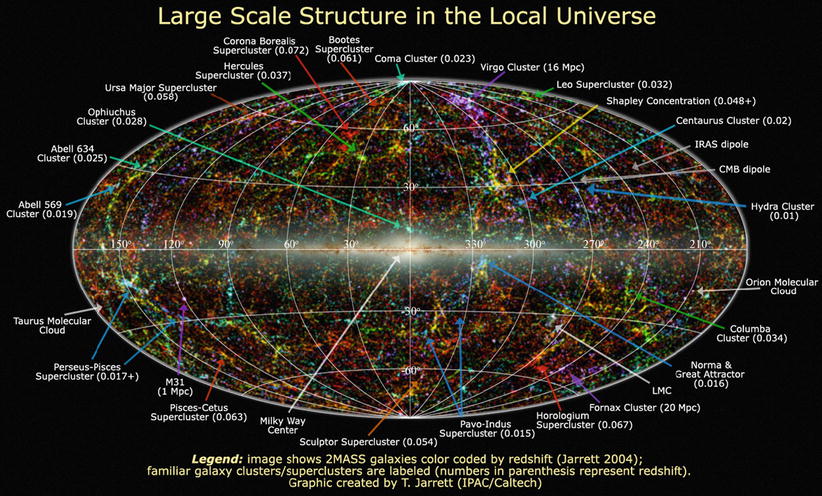
Fig. 1.52
A view of the full sky in near-IR light, as
obtained from the 2MASS Extended Source Catalog (XSC). Color codes
the distance of the galaxies, obtained from spectroscopic redshifts
of ∼ 105 galaxies, and estimated from their apparent
brightness for the other > 106 objects: blue indicates nearby galaxies (with
z < 0. 01), green (0. 01 < z < 0. 04) and red (0. 04 < z < 0. 1) show increasingly more
distant galaxies. In addition, the intensity is related to the
brightness of objects to enhance the contrast. The map is shown in
Galactic coordinates, such that the Galactic center is at the
center of the image—there, the Milky Way is intransparent even to
near-IR radiation, and thus the distribution of stars as observed
in 2MASS is shown. Several of the most obvious structures are
labeled. In particular one sees that the distribution of galaxies
is highly structured. Credit: T. Jarrett, IPAC/Caltech
The Leiden-Argentine-Bonn (LAB) survey covers the
whole sky in the 21-cm emission line of neutral hydrogen, within a
velocity range of ± 400 km∕s. With its angular resolution of ∼ 36′
and velocity resolution of 1. 3 km∕s it maps the neutral hydrogen
in and around our Milky Way. Other surveys at radio frequencies
include the NRAO VLA Sky Survey (NVSS) , which covers the sky North
of − 40∘ declination at 1. 4 GHz, and the Bonn 408-MHz
All-Sky Survey.
Deep
multi-waveband Surveys. In order to understand the
properties of galaxies and QSOs, data from a large range of
wavelengths are required. Accounting for that, surveys are
conducted on selected regions in the sky where several
observatories make a coordinated effort to obtain a
multi-wavelength data set. Perhaps the best-know example, and kind
of a prototype, is the Hubble Deep Field, mentioned before and
discussed in more detail in Sect. 9.2.1,
where the deep HST data were soon supplemented by deep observations
over all wavelengths, from the radio to the gamma-ray regime.
Encouraged by the success of the scientific exploration of the HDF,
several additional such surveys were carried out, including the
Hubble Ultradeep Field (HUDF), the Great Observatories Origins Deep
Survey (GOODS), the Galaxy Evolution from Morphology and Spectral
Energy Distributions (GEMS) and the Cosmological Evolution Survey
(COSMOS), with a sky coverage between that of the field-of-view of
the ACS camera (HUDF) and nearly two square degrees (COSMOS). In
all cases, a large number of other observatories acquired deep
images in the same sky region to obtain the broadest waveband
coverage possible, in addition to extended spectroscopic
campaigns.
These deep multi-waveband surveys have yielded a
large suite of results, mainly for distant objects. For each source
in the survey field, the broad-band energy distribution is
available and can be used to interpret the physical nature of the
object—for example, normal galaxies can be distinguished from
galaxies with weak nuclear activity which may show up in X-rays
only. Unobscured star formation can be detected in the UV-part of
the spectrum, whereas star formation hidden by dust shows up at
infrared wavelengths. These surveys are also used for statistical
properties of the galaxy population—for example, one can study the
fraction of optically bright galaxies which show signs of nuclear
activity in X-rays or in the radio. Using several optical and
infrared bands, the redshift of an object can be estimated rather
accurately, using the method of photometric redshifts (see
Sect. 9.1.2). To end this highly
incomplete list, one can search for rare objects in such
surveys—for example those which are well detected in several
near-IR bands, but show no sign of optical flux. As we will learn
lateron (see Sect. 9.2.4), such an object is a very
strong candidate for a galaxy with very high redshift.
Data bases and
Virtual Observatories. Many of the surveys are designed to
be of versatile use for many different research fields. In order
for other astronomers to make use of the data, they have to be
stored in well-organized data bases where the requested information
can be readily searched for. But not only surveys are a valuable
source of information for a wide range of applications; targeted
observations of particular objects yield data sets which may be of
interest to researchers other than the proposer of that
observations. For space observatories, it has become standard for a
long time that the data are stored in archives, and that every
astronomer has access to the data in these archives, usually with a
proprietary period of 1 year in which only the proposer has this
access, to allow her to scientifically exploit the data and publish
the results. Also several major ground-based facilities operate in
this manner, where data (science plus calibration data) are made
available to the community via dedicated archives.
In order to make the different data archives
mutually compatible, new standards for data formats and storage
systems are being developed. The goal of these virtual observatory
initiatives is to develop a common platform in which astronomers
can get with little effort a multi-wavelength image of selected
regions in the sky, where the data at different wavelengths are
stored in different archives spread around the world. The data
included in a virtual observatory is not restricted only to
observations, but can include simulation results as well. For
example, results from cosmological simulations of the large-scale
matter distribution in the Universe can be transformed into a mock
sky map of the simulated sources, which can be analyzed in the same
way as real data to allow for comparisons between observations and
model predictions. In this way, one aims for making optimal use of
valuable (and expensive) data.
1.5 Problems
1.1. Age
of the Universe. Based on the Hubble law (1.2), we can get a simple
first estimate of the age of the Universe. Consider a galaxy at
distance D whose radial
velocity is given by (1.2), and assume that this velocity was the same
throughout cosmic time. In this case, at some time in the past the
separation was zero, and we can identify that instant as the Big
Bang. Under these assumptions, calculate the current age of the
Universe using (1.7). Does it depend on the choice of the
galaxy, i.e., the current distance D? Compare your result with the age of
the oldest stars found in our Galaxy, which is about 12 ×
109 yr. Since no signal can propagate faster than the
speed of light c, the age
of the Universe times the speed of light is often called the ‘size
of the visible Universe’. How large is that?
1.2. Sky
fraction filled with nearby galaxies. The mean number
density of luminous galaxies in the local Universe is about
 . Assume
that they are uniformly distributed, and that the diameter of their
luminous region is about 20 kpc, comparable to that of the Milky
Way. How many of these galaxies are contained in a sphere with
radius
. Assume
that they are uniformly distributed, and that the diameter of their
luminous region is about 20 kpc, comparable to that of the Milky
Way. How many of these galaxies are contained in a sphere with
radius  around us? How many
of these galaxies will be seen per square degree on the sky? What
is the fraction of the sky which luminous galaxies within a
distance of r 0
subtend?
around us? How many
of these galaxies will be seen per square degree on the sky? What
is the fraction of the sky which luminous galaxies within a
distance of r 0
subtend?
 . Assume
that they are uniformly distributed, and that the diameter of their
luminous region is about 20 kpc, comparable to that of the Milky
Way. How many of these galaxies are contained in a sphere with
radius
. Assume
that they are uniformly distributed, and that the diameter of their
luminous region is about 20 kpc, comparable to that of the Milky
Way. How many of these galaxies are contained in a sphere with
radius  around us? How many
of these galaxies will be seen per square degree on the sky? What
is the fraction of the sky which luminous galaxies within a
distance of r 0
subtend?
around us? How many
of these galaxies will be seen per square degree on the sky? What
is the fraction of the sky which luminous galaxies within a
distance of r 0
subtend?1.3. Density of the Universe. Our Universe has
a mean matter density ρ
m given by (1.10), with Ω m ≈ 0. 3. About 15 % of
this mass density in contributed by baryonic matter, i.e., protons,
neutrons and electrons, yielding a baryonic mass density of
ρ
b ≈ 0. 15 ρ
m. Use h ≈ 0. 71, or h 2 ≈ 1∕2 for this exercise.
1.
The closest star to the Sun has a distance
slightly larger than 1 pc, so that we can estimate the local mass
density to be  .
Compare this value with ρ
b.
.
Compare this value with ρ
b.
 .
Compare this value with ρ
b.
.
Compare this value with ρ
b.2.
From the rotational velocity V 0 ≈ 220 km∕s of the Sun
around the center of the Milky Way, we obtain the mass M(R 0) of the Milky Way
contained in a sphere of radius R 0 ≈ 8 kpc from the
law (1.1)
of Kepler rotation. By which factor is the mean density inside
R 0 larger than
ρ m?
3.
If you place a cube of 1 m side-length at a
random point in the Universe, how many baryons do you expect to
find in it on average?
1.4. Free-fall time. Consider a sphere of mass
M and initial radius
r 0. If there is
no pressure acting against gravity, and if there is no
outward-directed motion of the matter in the sphere, the sphere
will reduce its radius, and in the idealized case considered here,
collapse to a single point in a finite time. According to Newton’s
law of gravity, the radius evolves in time obeying the equation of
motion


The solution of this equation depends on the
initial velocity, as well the initial radius, and requires some
algebra. However, a simple solution can be obtained by the ansatz
 ,
where
,
where  .
.
 ,
where
,
where  .
.
1.
Show that this ansatz leads indeed to a solution
of the equation of motion, and determine the two parameters
α and t f. Describe the
qualitative behavior of the solution r(t).
2.
Show that the time-scale t f, i.e., the time it takes
the sphere to collapse to a point, depends only on the mean initial
density of the sphere. What is this time-scale for a density
corresponding to the mean density inside the inner 8 kpc of our
Galaxy? Hint: Make use of the fact that you know the orbital time
of the Sun around the center of the Milky Way, t orb ≈ 2. 3 ×
108 yr.
3.
What is the time-scale t f if the density is the
mean density of the current Universe? How does this compare to the
age of the Universe estimated in Problem 1.1? What is t f for the Einstein–de
Sitter model with density (1.14), and how does this compare to the current
age of the Universe in the EdS model, given by (1.13)? Can you interpret
your finding?
Footnotes
2
1 parsec (1 pc) is the common unit of distance in
astronomy, with 1 pc = 3. 086 × 1018 cm. Also used are
1 kpc = 103 pc, 1 Mpc = 106 pc,
1 Gpc = 109 pc. Other commonly used units and constants
are listed in Appendix C.
4
Strictly speaking, (1.1) is valid only for a
spherically symmetric mass distribution. However, the rotational
velocity for an oblate density distribution does not differ much,
so we can use this relation as an approximation.
5
What is observed is the wavelength shift of
spectral lines. Depending on the context, it is interpreted either
as a radial velocity of a source moving away from us—for instance,
if we measure the radial velocity of stars in the Milky Way—or as a
cosmological escape velocity, as is the case for the Hubble law. It
is in principle impossible to distinguish between these two
interpretations, because a galaxy not only takes part in the cosmic
expansion but it can, in addition, have a so-called peculiar
velocity. We will therefore use the words ‘Doppler shift’ and
‘redshift’, respectively, and ‘radial velocity’ depending on the
context, but always keeping in mind that both are measured by the
shift of spectral lines. Only when observing the distant Universe
where the Doppler shift is fully dominated by the cosmic expansion
will we exclusively call it ‘redshift’.
6
The distances of these two clusters are not
determined from redshift measurements, but by direct methods that
will be discussed in Sect. 3.9; such direct measurements are
one of the most successful methods of determining the Hubble
constant.
7
In Chap. 3 we will see that for stars in
spiral galaxies  on average, while
for those in elliptical galaxies a larger value of
on average, while
for those in elliptical galaxies a larger value of  applies. Here and
throughout this book, mass-to-light ratios are quoted in Solar
units.
applies. Here and
throughout this book, mass-to-light ratios are quoted in Solar
units.
 on average, while
for those in elliptical galaxies a larger value of
on average, while
for those in elliptical galaxies a larger value of  applies. Here and
throughout this book, mass-to-light ratios are quoted in Solar
units.
applies. Here and
throughout this book, mass-to-light ratios are quoted in Solar
units.8
The virial theorem in its simplest form says
that, for an isolated dynamical system in a stationary state of
equilibrium, the kinetic energy is just half the potential energy,
 In particular, the system’s total energy is
In particular, the system’s total energy is  .
.

(1.8)
 .
.9
This was already known in 1915, but it was not
clear whether it might not have any other explanation, e.g., a
quadrupole moment of the mass distribution of the Sun.
10
In the Earth-Sun system, there are five
points—called Lagrange points, where the total force, i.e., the sum
of the gravitational forces of Sun plus Earth and the centrifugal
force all balance to zero. Objects located at these Lagrangian
point will thus orbit at the same angular velocity around the Sun
as the Earth. The Lagrange point L2 is located on the line
connecting Sun and Earth, about 1. 5 × 106 km outside
the Earth orbit. A satellite located there always sees Sun and
Earth in the same direction and can thus be shielded from their
radiation. The L2 point is therefore a preferred location for
astronomical satellites.
11
The 13 telescopes with diameter > 8 m are: The
two Keck telescopes, the four VLTs, Gemini-North (Mauna Kea) and
Gemini-South (Chile), Subaru (Mauna Kea), the Hobby–Eberly
Telescope (McDonald Observatory, Texas), the Large Binocular
Telescope in Arizona consisting of two telescopes (see
Fig. 1.44
below), and the Gran Telescopio Canarias at the Roque de los
Muchachos Observatory on La Palma, Spain.
12
The point-spread function (PSF)  describes the shape of the
brightness profile of a point source as seen in the detector. Owing
to seeing and diffraction effects, it has a finite width. The
images of extended sources are also affected by the PSF: each small
part of an extended sources can be considered as a point source,
whose brightness in the detector is smeared by the PSF. Thus, if
describes the shape of the
brightness profile of a point source as seen in the detector. Owing
to seeing and diffraction effects, it has a finite width. The
images of extended sources are also affected by the PSF: each small
part of an extended sources can be considered as a point source,
whose brightness in the detector is smeared by the PSF. Thus, if
 is the true brightness
profile, the observed one is given by
is the true brightness
profile, the observed one is given by
 where P is normalized to
unity,
where P is normalized to
unity,  .
.
 describes the shape of the
brightness profile of a point source as seen in the detector. Owing
to seeing and diffraction effects, it has a finite width. The
images of extended sources are also affected by the PSF: each small
part of an extended sources can be considered as a point source,
whose brightness in the detector is smeared by the PSF. Thus, if
describes the shape of the
brightness profile of a point source as seen in the detector. Owing
to seeing and diffraction effects, it has a finite width. The
images of extended sources are also affected by the PSF: each small
part of an extended sources can be considered as a point source,
whose brightness in the detector is smeared by the PSF. Thus, if
 is the true brightness
profile, the observed one is given by
is the true brightness
profile, the observed one is given by

 .
.13
This is due to the fact that the ionization cross
section behaves approximately as ∝ ν −3, where ν is the photon frequency; hence, the
probability that a photon will be absorbed through photo-ionization
of neutral hydrogen is ∼ 1000 times smaller at 0. 1 keV than at the
Lyman limit.